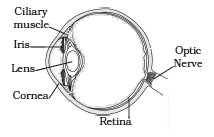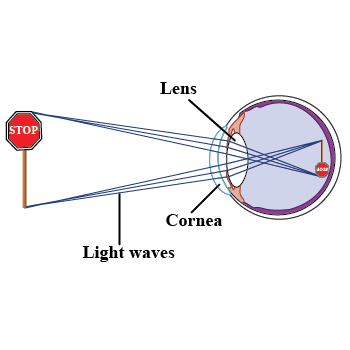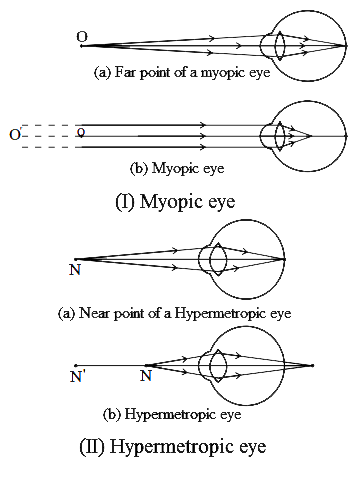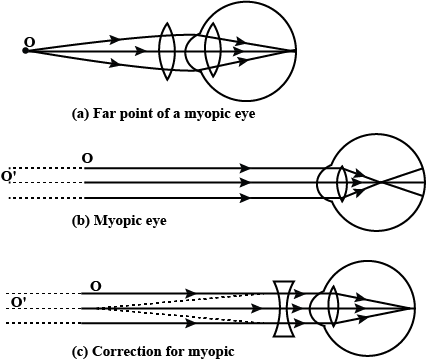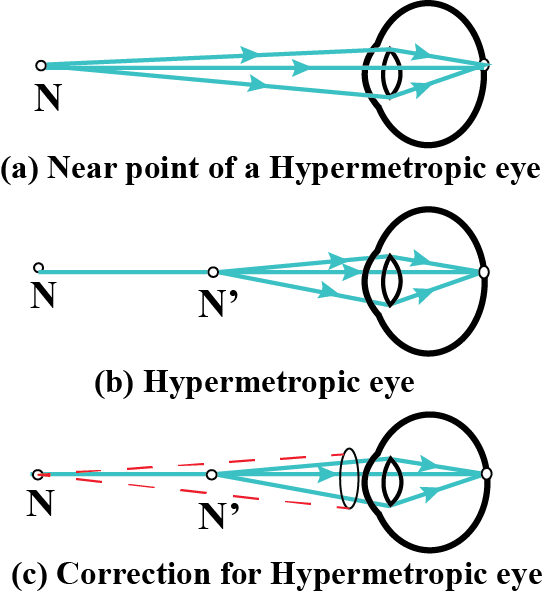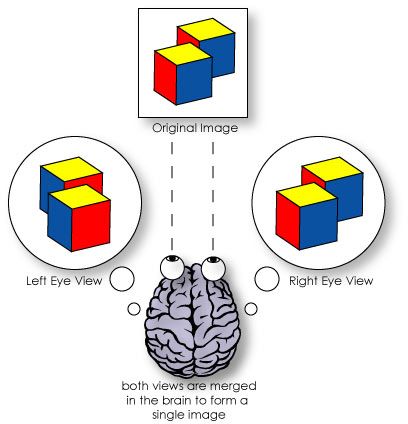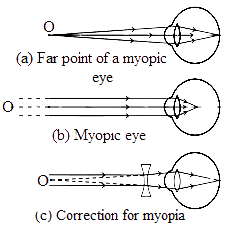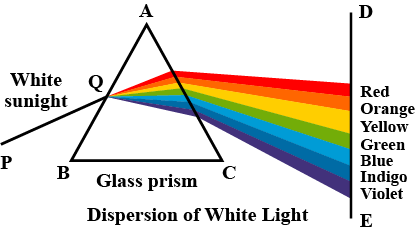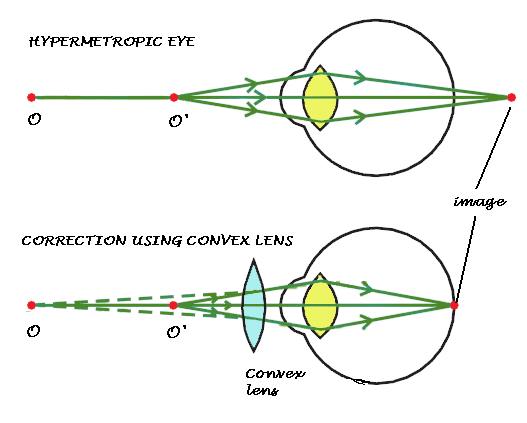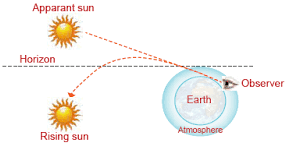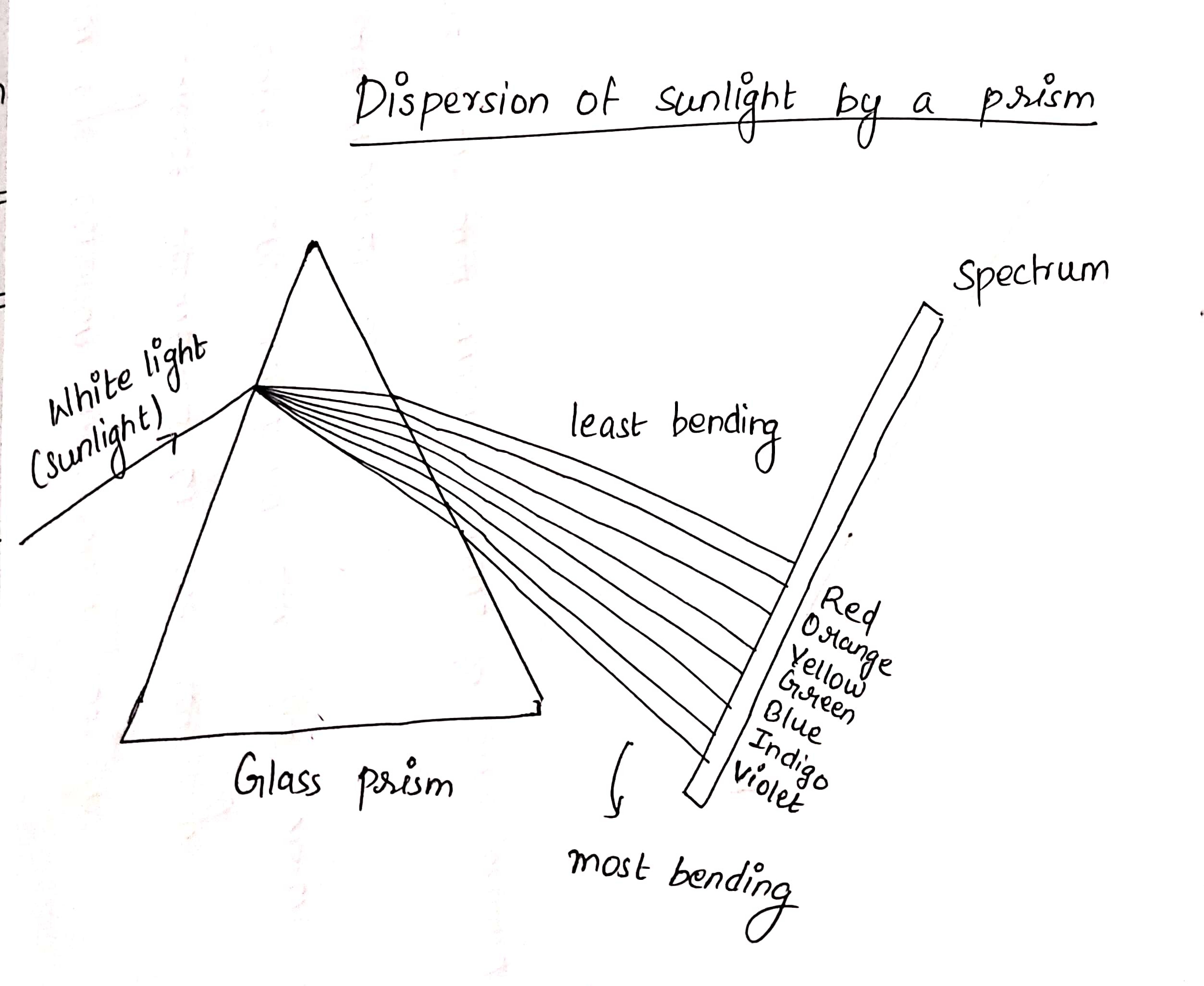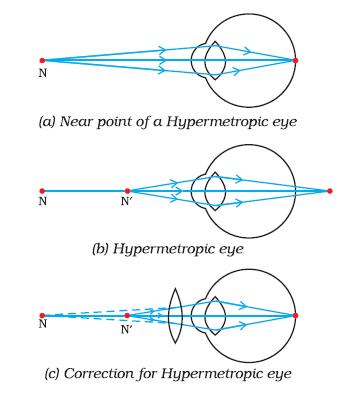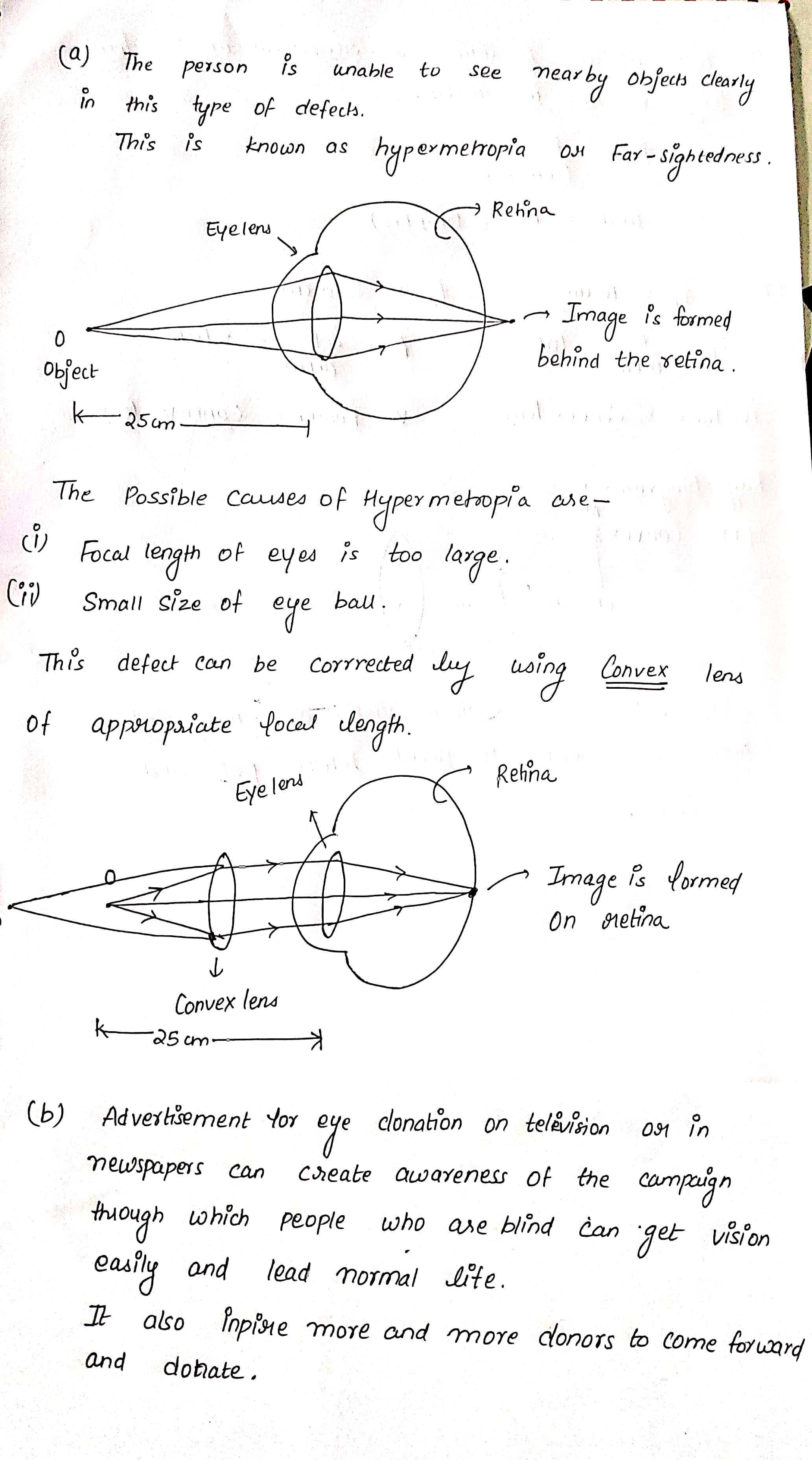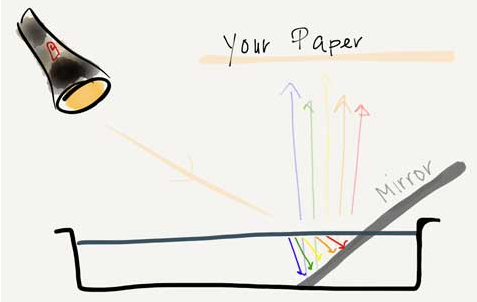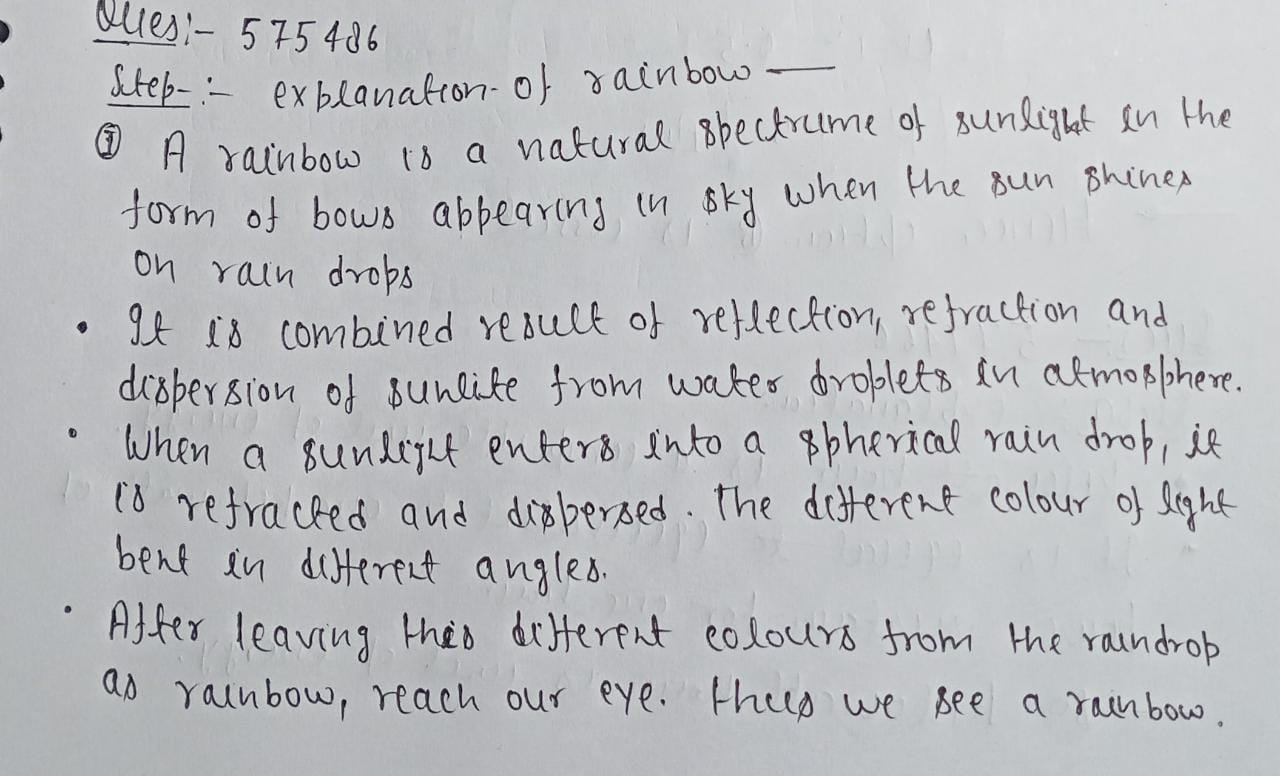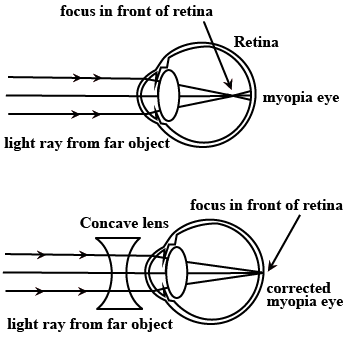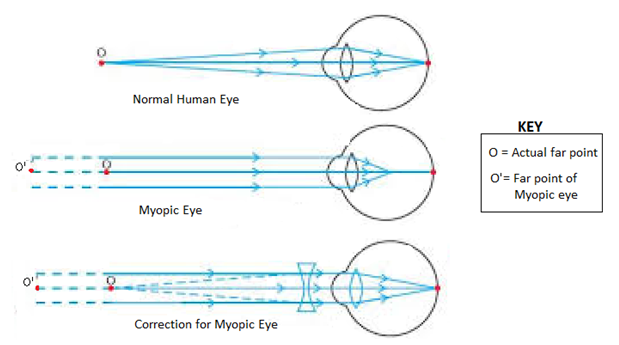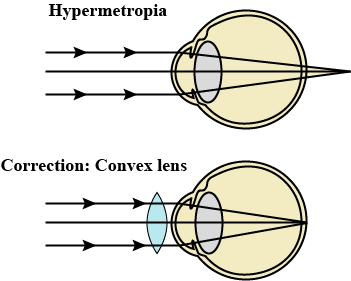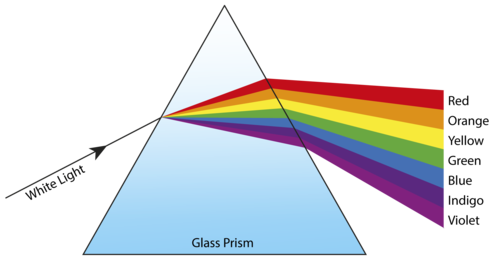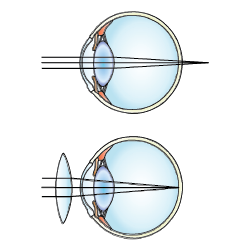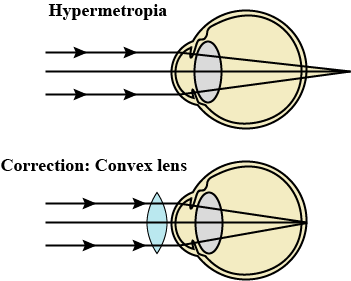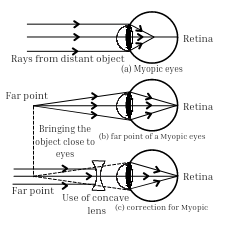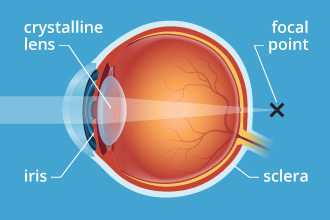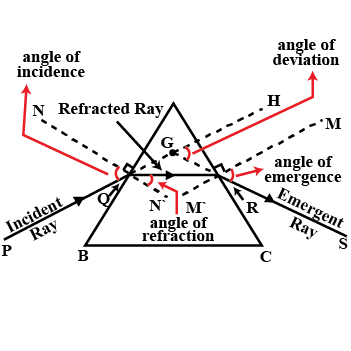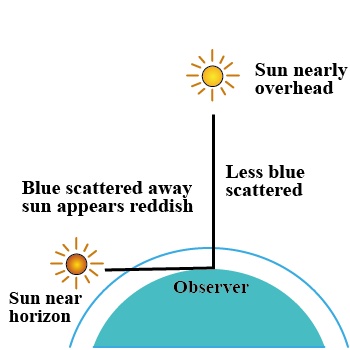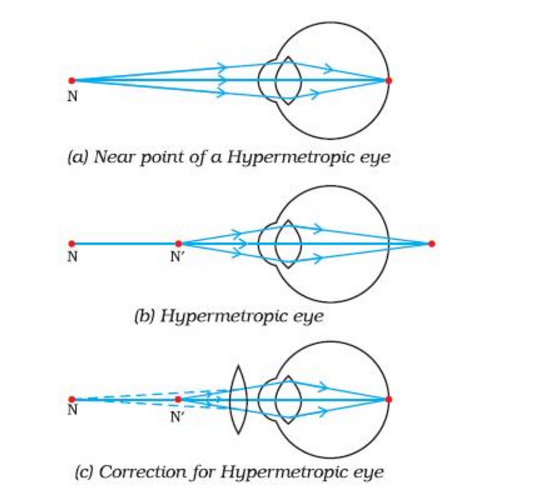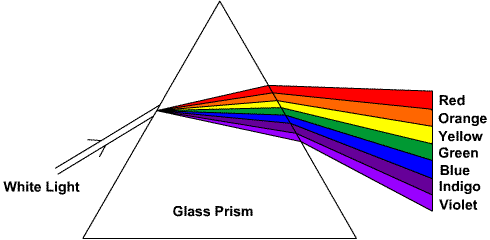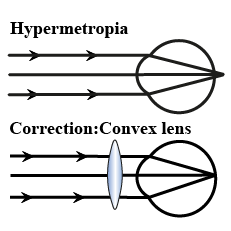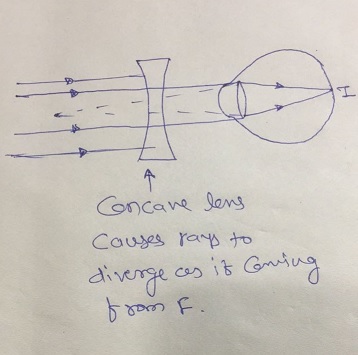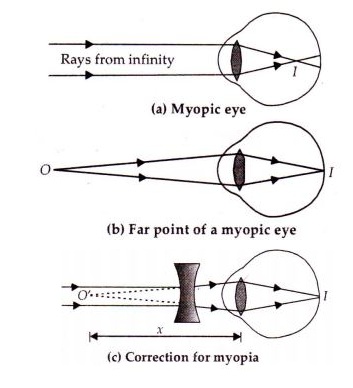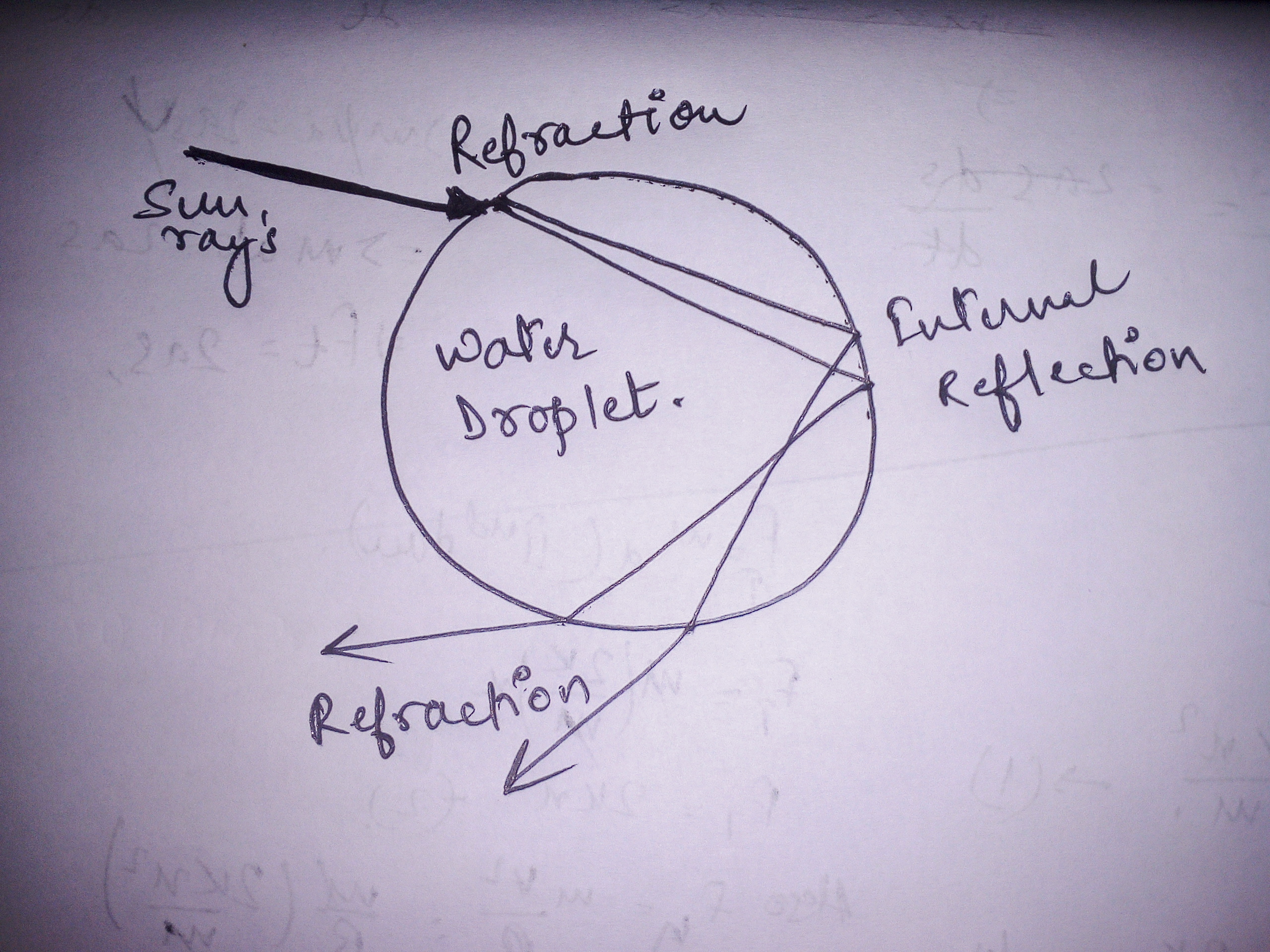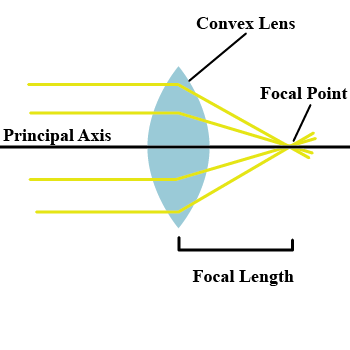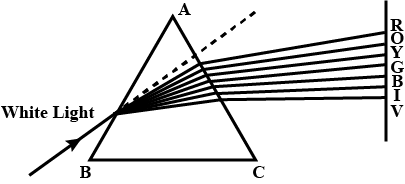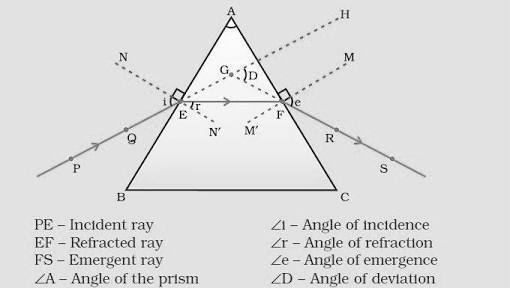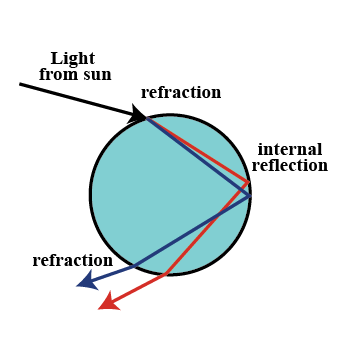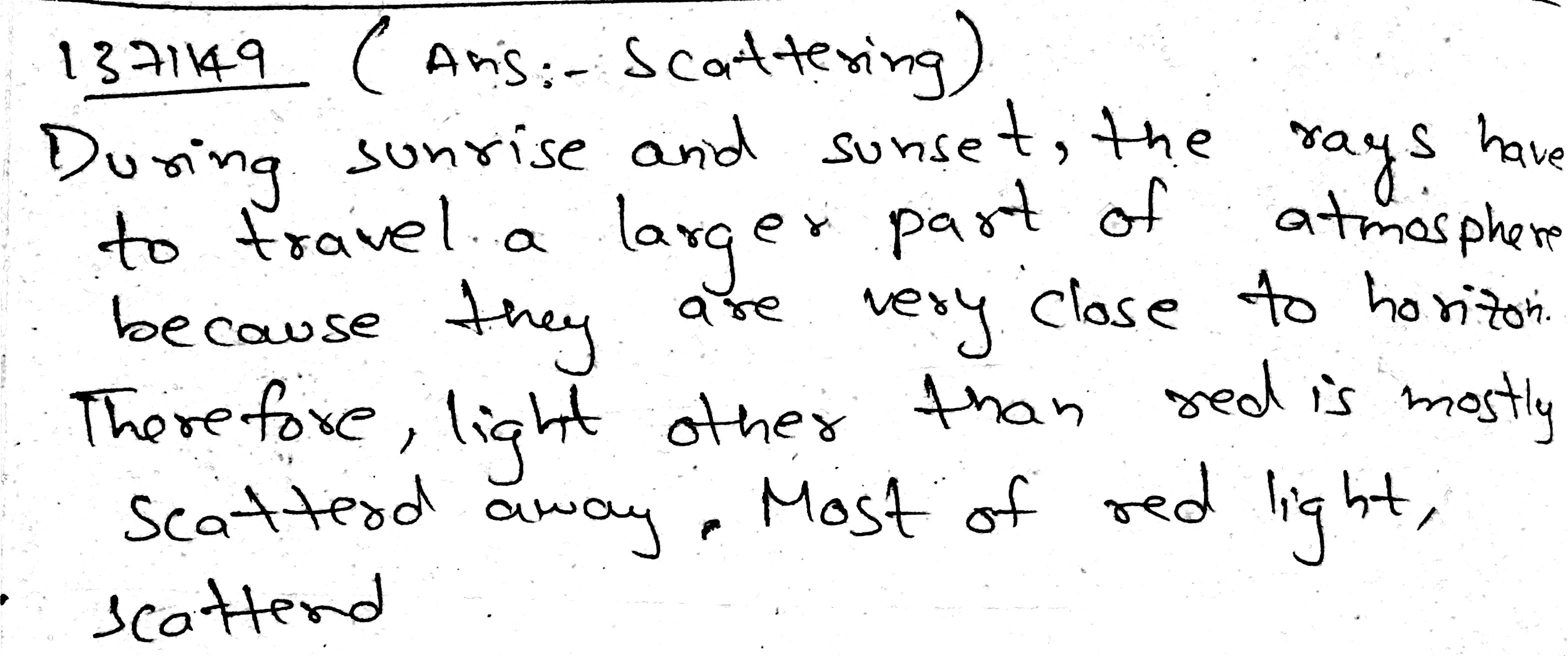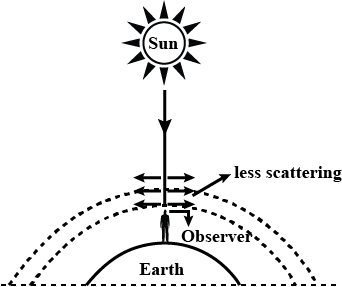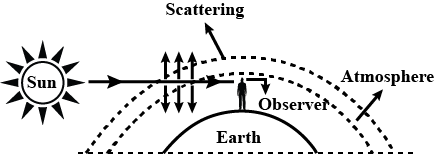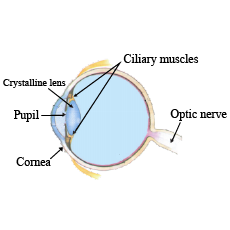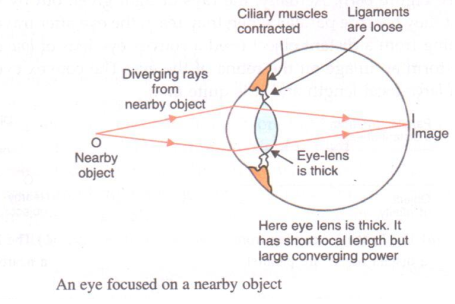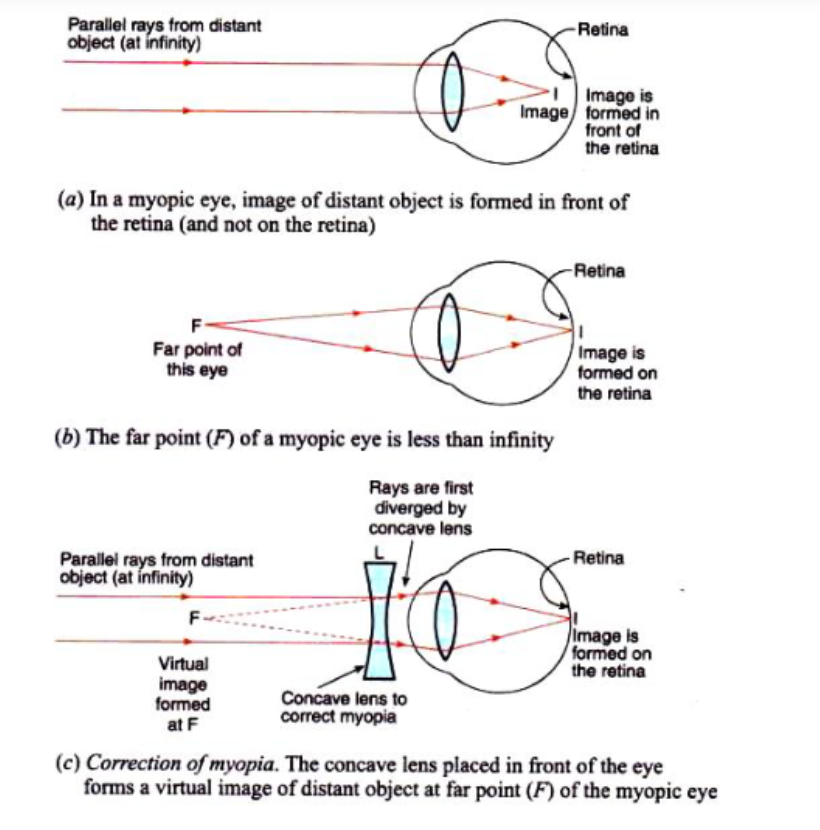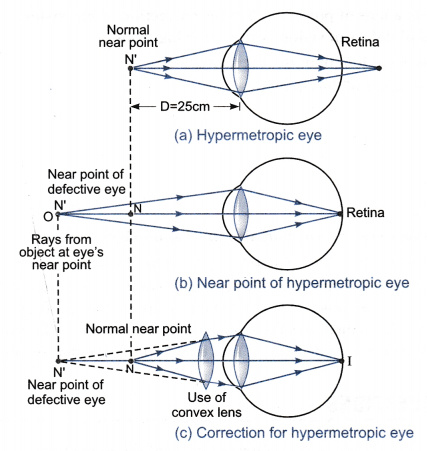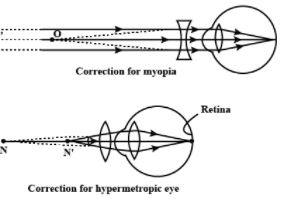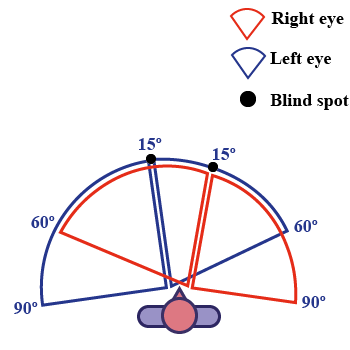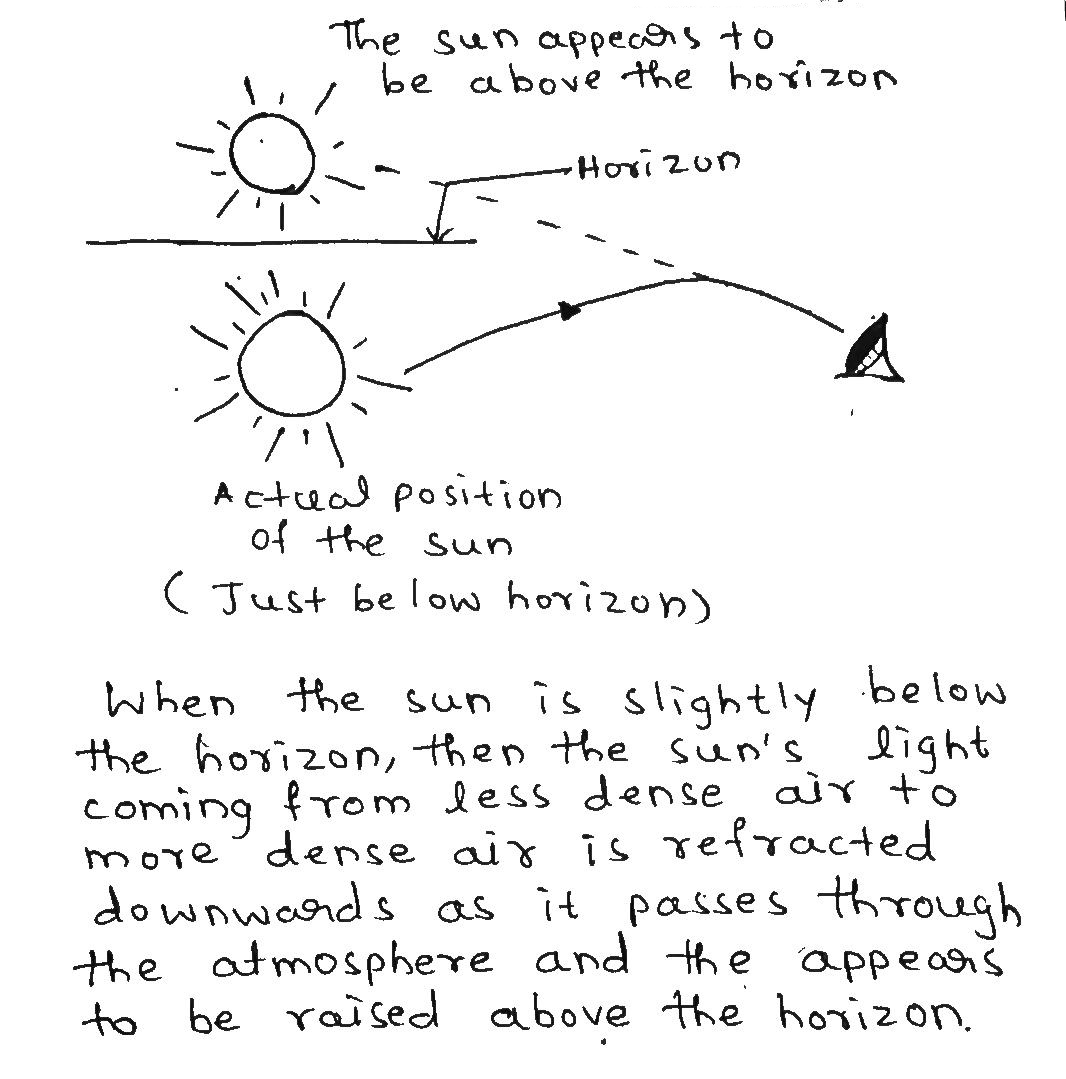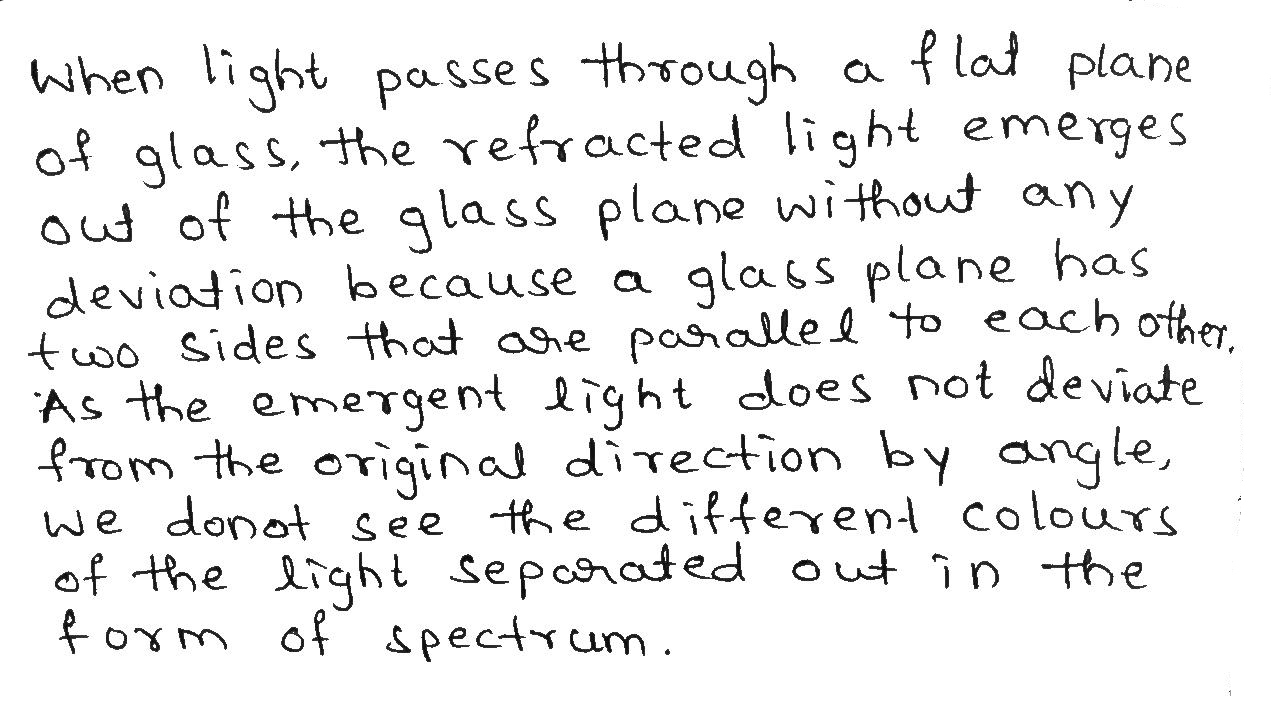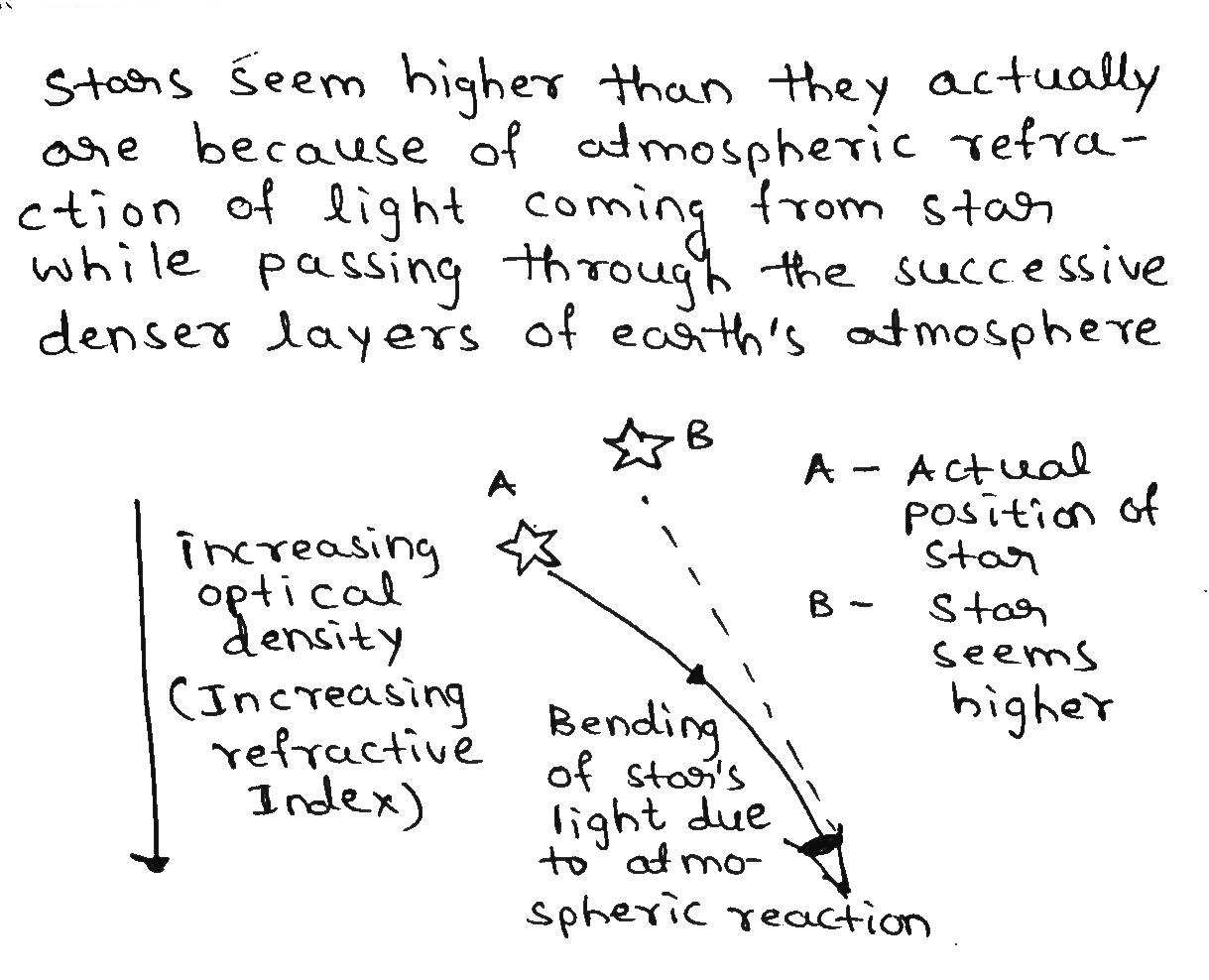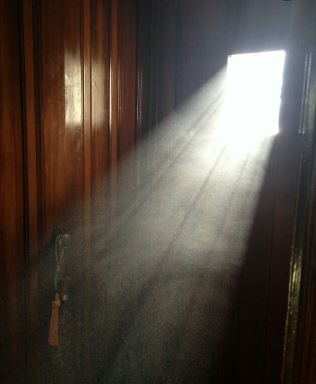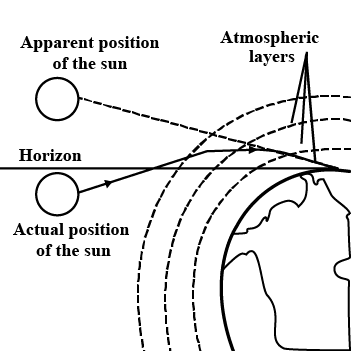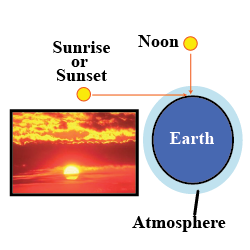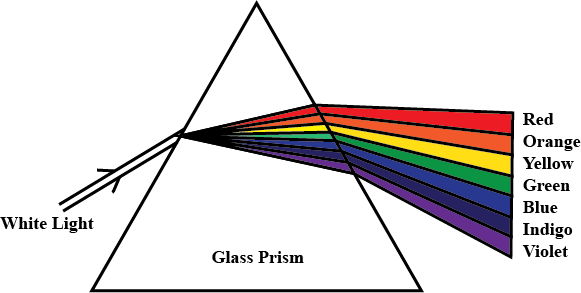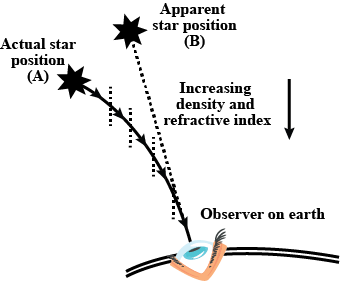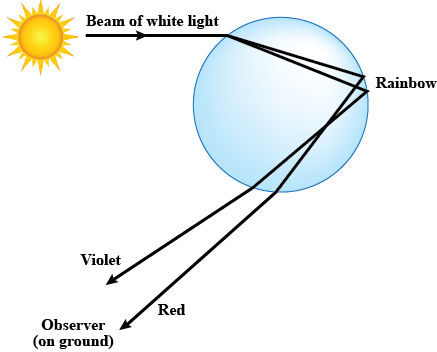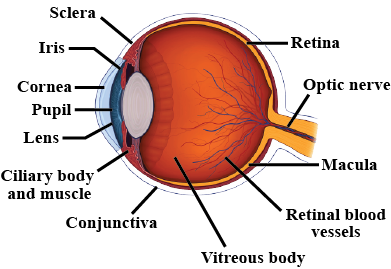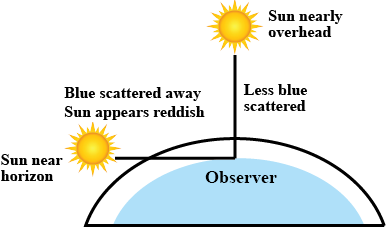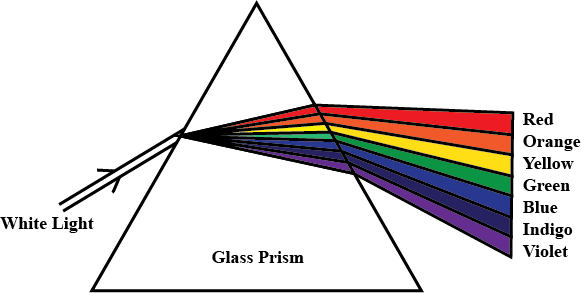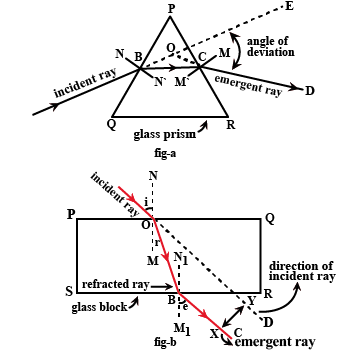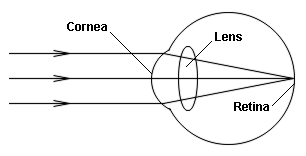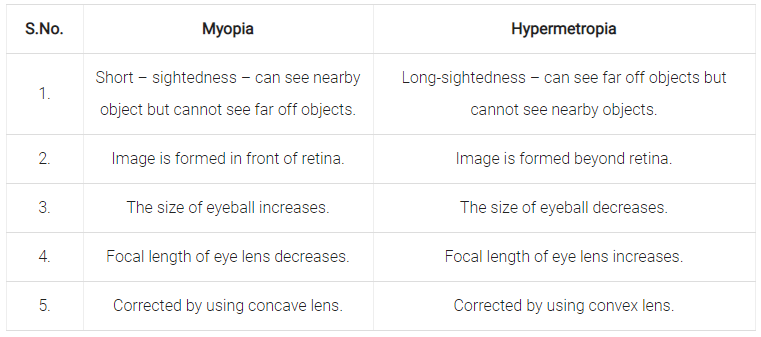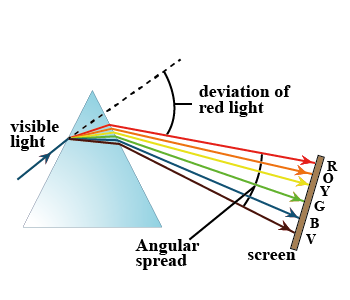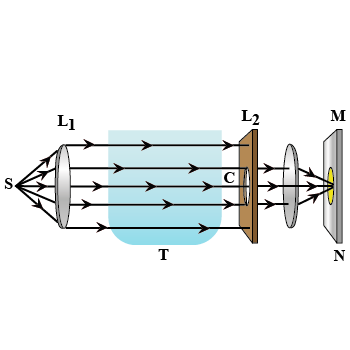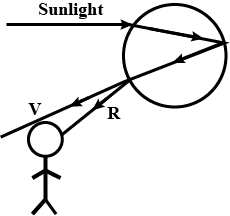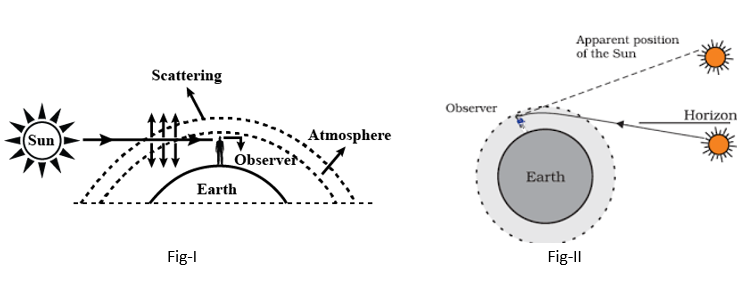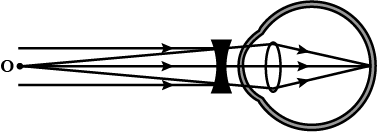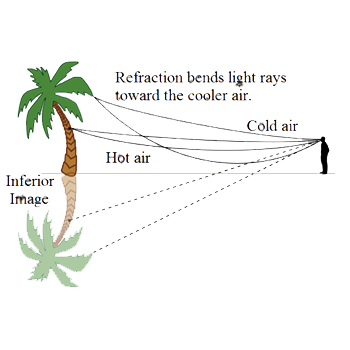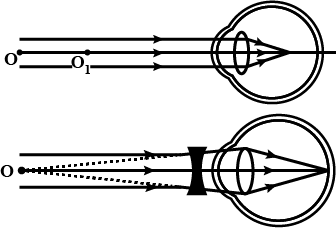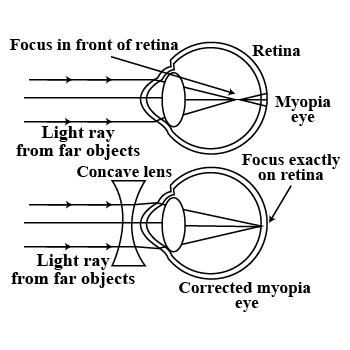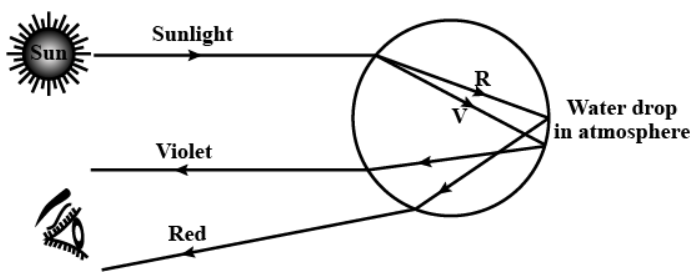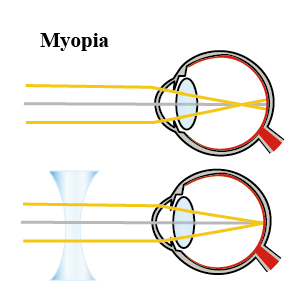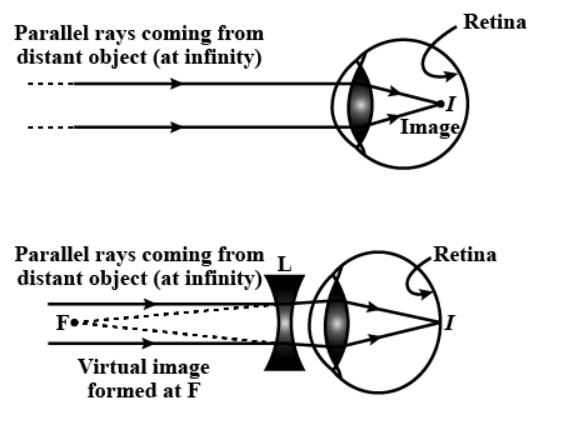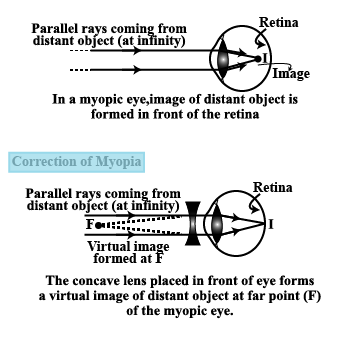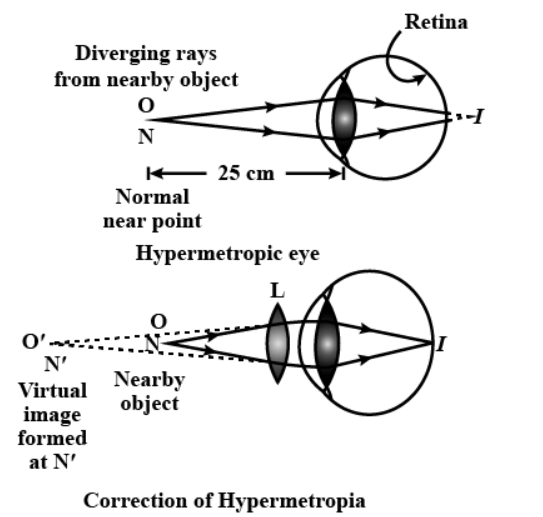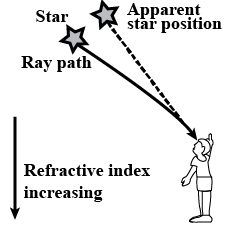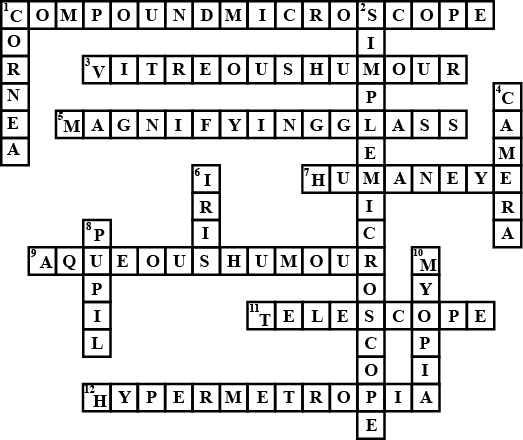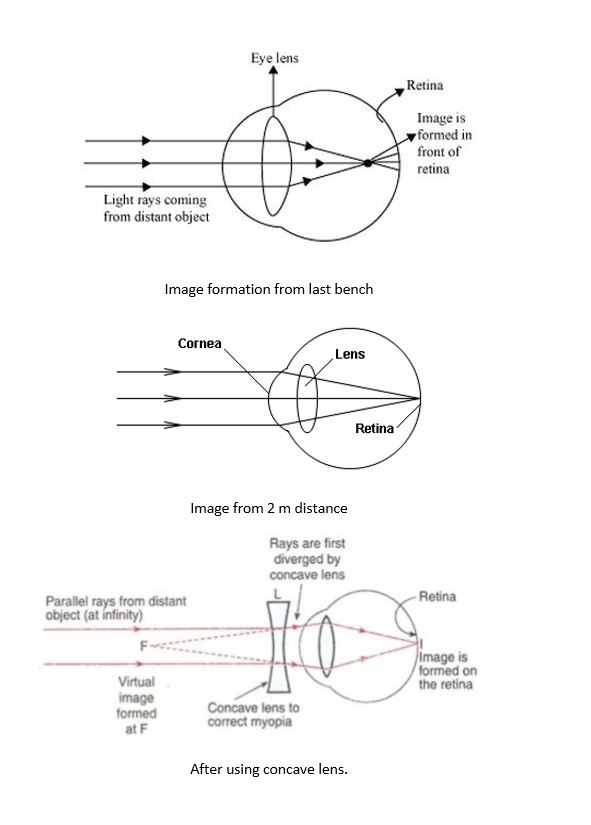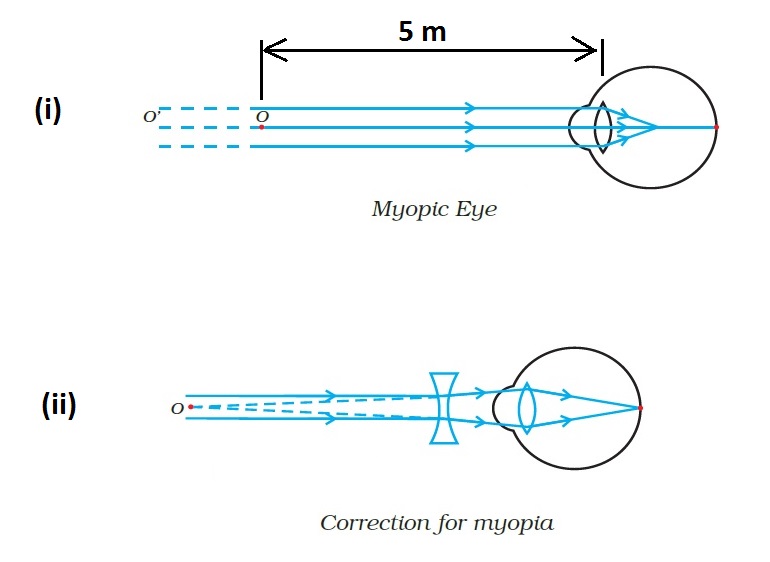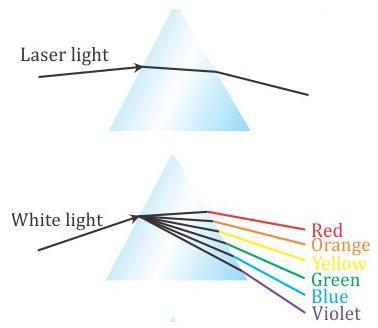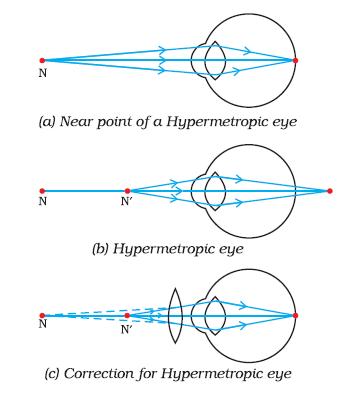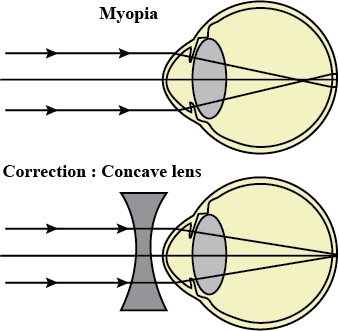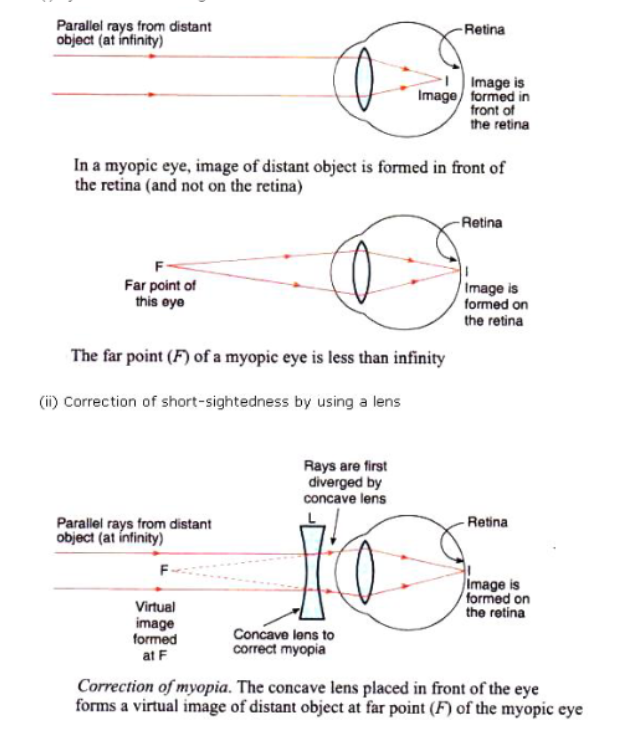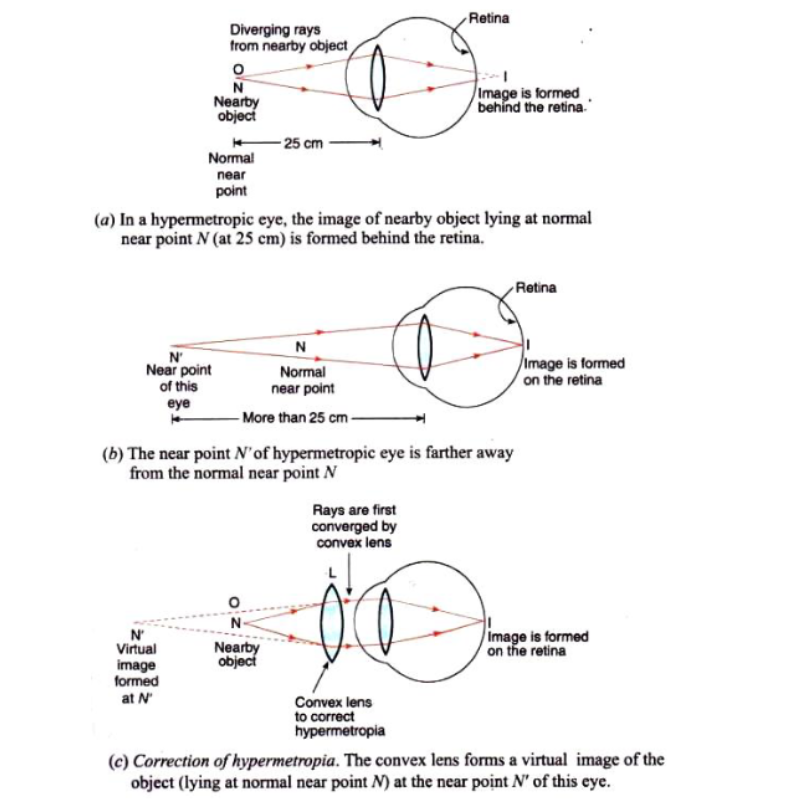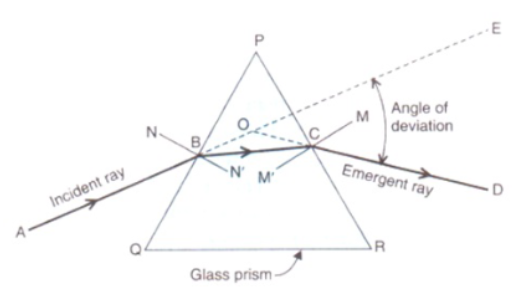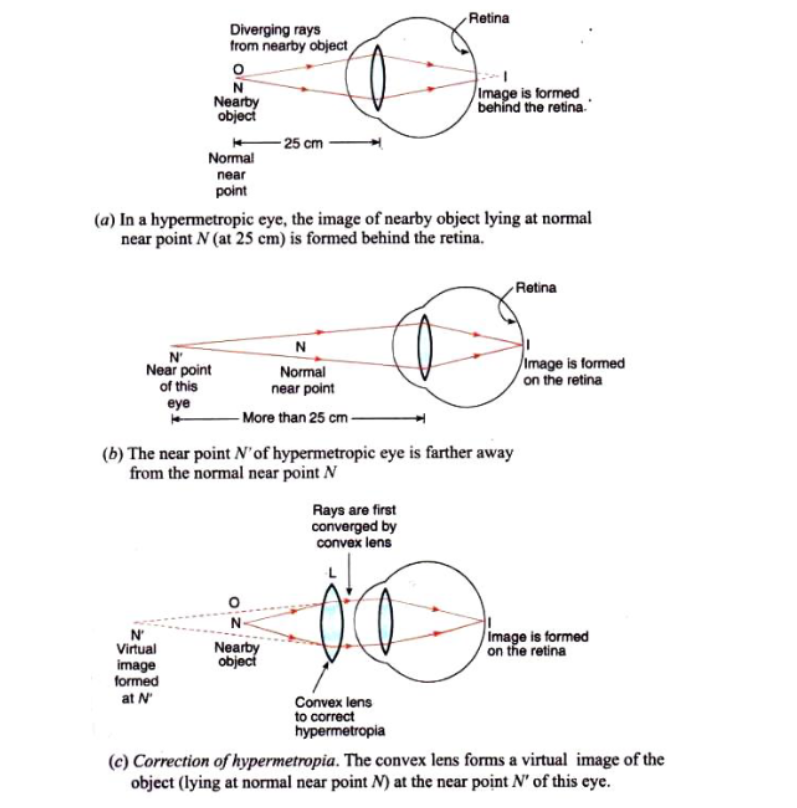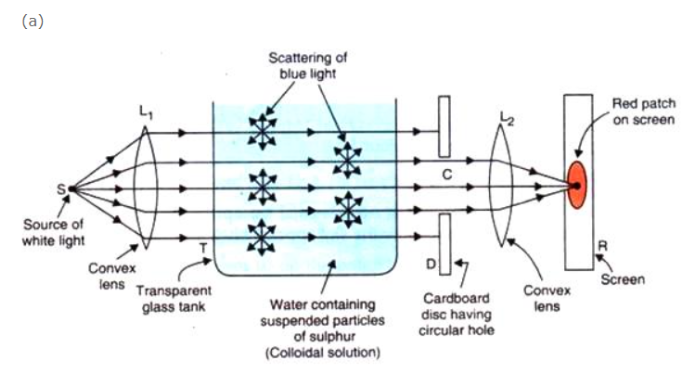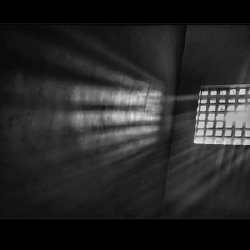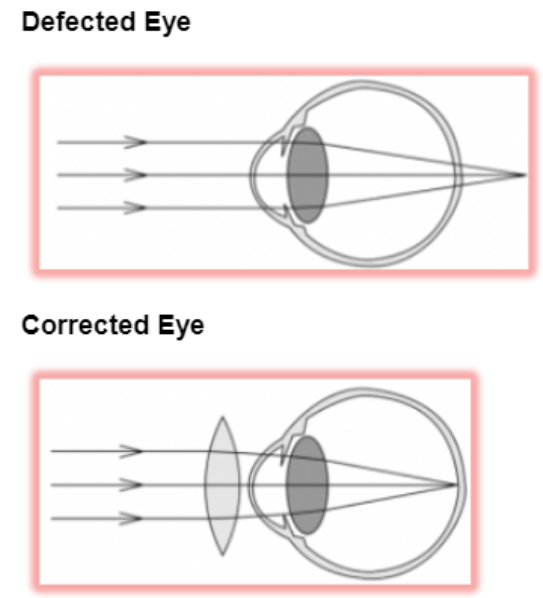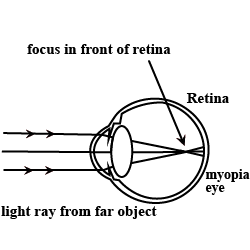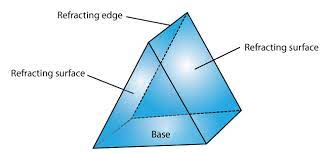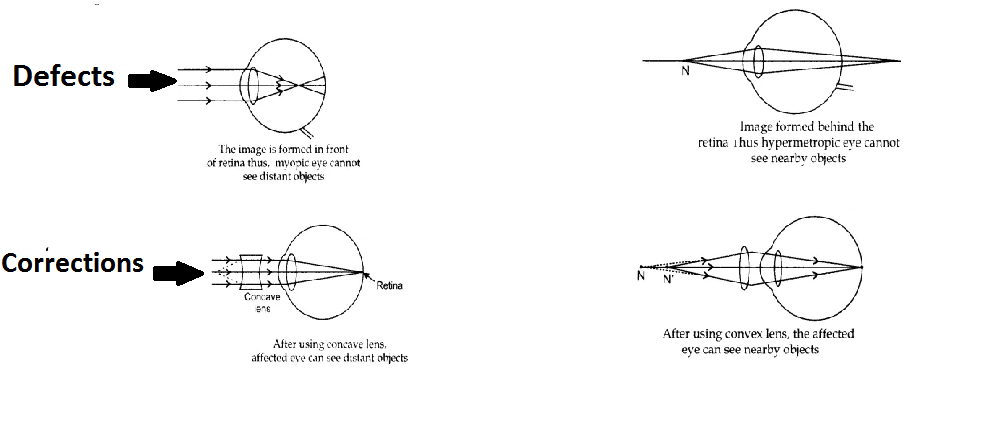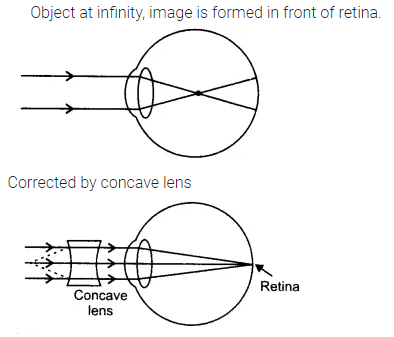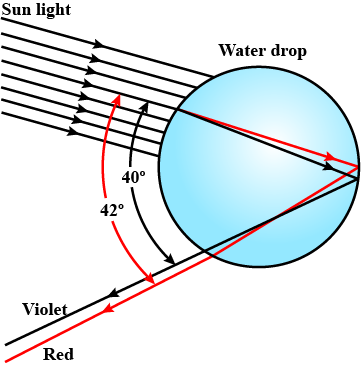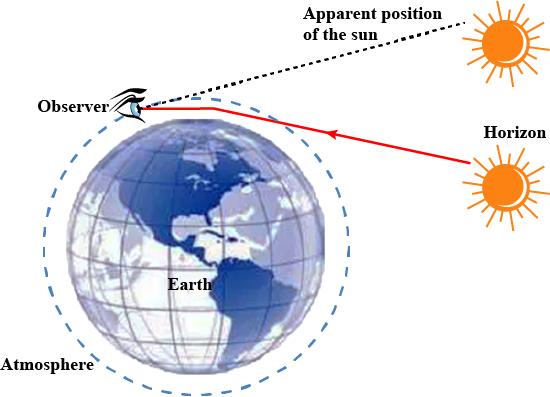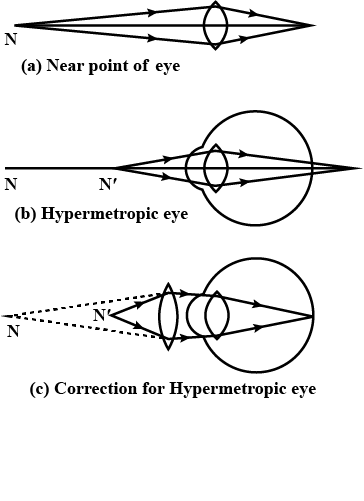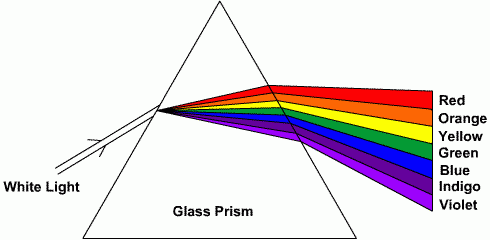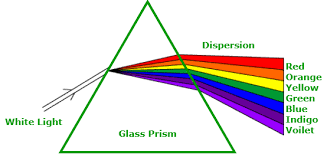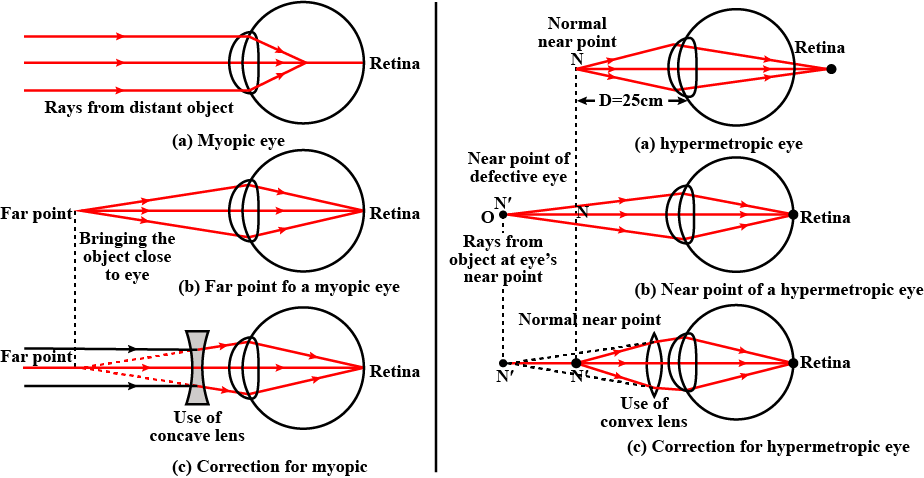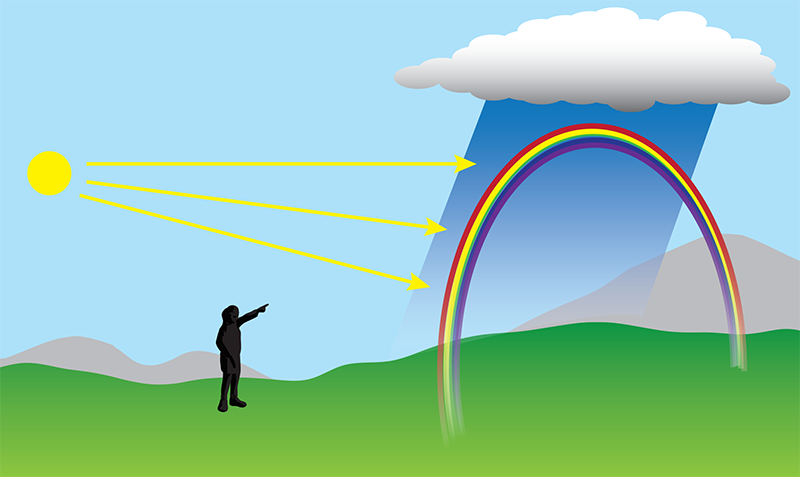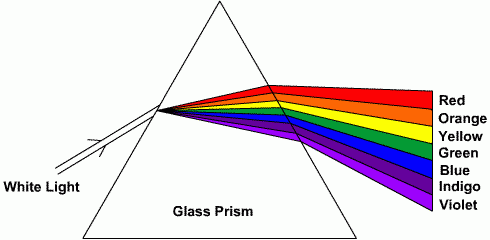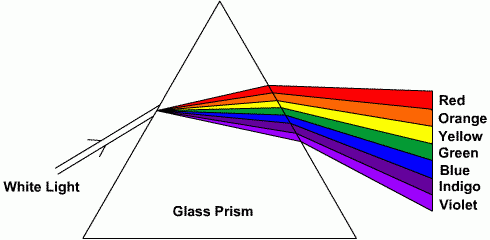Human Eye And Colorful World - Class 10 Physics - Extra Questions
The impression of an image on the brain lasting for one-sixteenth of a second is called ........
Answer the following.State the function of iris and ciliary muscles in human eye.
Draw a labeled sketch of the human eye.
Why can't we see clearly through fog? Name the phenomenon responsible for it.
Why is a normal eye not able to see clearly the objects placed closer than 25 cm?
What is the ability of the eye lens to adjust its focal length called?
Which part of the human eye helps in changing the focal length of the eye lens?
A doctor has prescribed a corrective lens of power $$+1.5D$$. Find the focal length of the lens. Is the prescribed lens diverging or converging?
Myopia can be corrected by using _____ lens.
What does this $$\lambda$$ symbol indicates in the context of sound wave?
An object is moved closer to an eye. What changes must take place in the eye in order to keep the image in sharp focus?
A swimmer sees only hazy contours of objects when he opens his eyes under water, while they are distinct when using a mask. Why?
Draw ray diagrams each showing (i) myopic eye and (ii) hypermetropic eye.
Write down the names of parts of the eye in the blank spaces shown in Fig. 16.10.
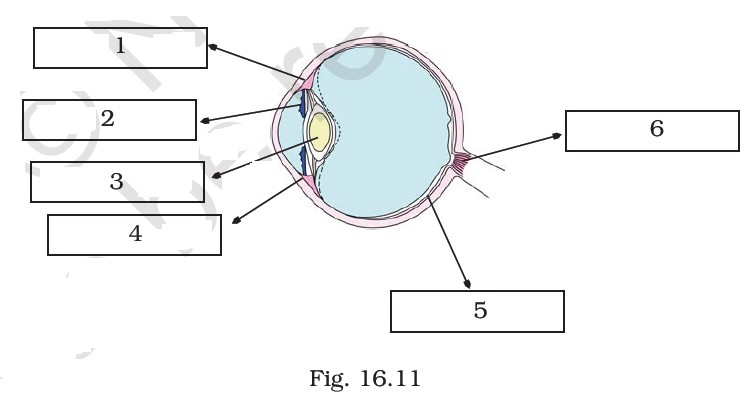
A student sitting at the back of the classroom cannot read clearly the letters written on the blackboard. What advice will a doctor give to her? Draw ray diagram for the correction of this defect.
A person is advised to wear spectacles with convex lenses. State the defect of vision he is suffering from.
What happens to the image distance from the eye lens in the normal eye when we increase the distance of an object from the eye ?
When an object can be seen with one eye, why is it that we have a pair of eyes?
An eye is said to be long-sighted if the image of a distant object is formed in front of the retina.
What is a long-sighted eye ? State one cause of long-sightedness. Name the lens used for correcting long-sightedness.
What is meant by the power of accommodation of eye?
Given is a diagram showing a defect of human eye.
Study it and answer the following question :Give two possible reasons for this defect of eye in human being.
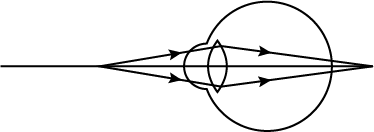
Give reasons: A concave lens is used to correct myopia.
Give reasons:The sun appears reddish early in the morning.
Fill in the blanks:Very fine particles mainly scatter ___________ light.
Give reasons:Stars twinkle at night.
Distinguish between Myopia and Hypermetropia.
Give reasons. In old age bifocal lens is necessary for person.
Where else in nature is this phenomenon observed ?
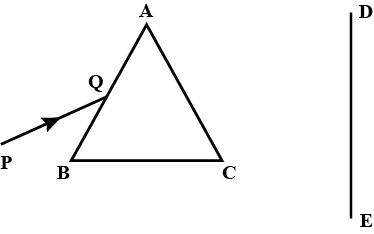
Tarun wears spectacles having convex lenses. When he tries to read a book by keeping it at a distance of 25 cm, the text print seems to be blurred. What conclusion can be drawn about the least distance of distinct vision of Tarun's eye ?
How does the defect of myopia arise in a human eye?
Draw a diagram to show how hypermetropia is corrected.
Explain myopia with the help of a ray diagram.
A person is looking at another person wearing a shirt with a pattern comprising of vertical and horizontal lines. He is able to see the vertical lines more distinctly than the horizontal ones. What is this defect due to? How is such a defect of vision corrected?
Does short-sightedness (myopia) or long-sightedness (hypermetropia) imply necessarily that the eye has partially lost its ability of accommodation? If not, what might cause these defects of vision?
A myopic person has been using spectacles of power $$-1.0\ D$$ for distant vision. During old age, he also needs to use a separate reading glass of power $$+ 2.0\ D$$. Explain what may have happened.
The far point of a myopic person is $$80\ cm$$ in front of the eye. What is the nature and power of lens required to correct the problem?
What happens to the image distance in the eye when we increase the distance of an object from the eye?
Why does the Sun appear reddish early in the morning?
Make a diagram to show how hypermetropia is corrected. The near point of hypermetropic eye is 1 m. What is the power of lens required to correct this defect? Assume that the near point of the normal eye is 25 cm.
A person needs a lens of power -5.5 diopters for correcting his distant vision. For correcting his near vision he needs a lens of power +1.5 diopters. What is the focal length of the lens required for correcting (i) distant vision (ii) near vision?
Why does the sky appear dark instead of blue to an astronaut?
What is atmospheric refraction? Use this phenomenon to explain the advanced sun-rise and delayed sun-set.
(a) List three common refractive defects of vision. Suggest a way of correcting these defects.
(b) About $$45\ lac$$ people in developing countries are suffering from corneal blindness. About $$30\ lac$$ children below the age of $$12$$ years suffering from this defect can be cured by replacing the defective cornea with the cornea of a donated eye. How and why can students of your age involve themselves to create awareness about this fact among people?
Draw a labelled ray diagram to illustrate the dispersion of a narrow beam of white light when it passes through a glass prism.
Why does bluish colour predominate in a clear sky?
What is meant by scattering of light? Use this phenomenon to explain why the clear sky appears blue or the Sun appears reddish at sunrise.
Write the importance of ciliary muscles in the human eye. Name the defect of vision that arises due to gradual weakening of the ciliary muscles. What types of lenses are required by the person suffering from this defect to see the objects clearly?
Akshay, sitting in the last row in his class, could not see clearly the words written on the blackboard. When the teacher noticed it, he announced if any student sitting in the front row could volunteer to exchange his seat with Akshay. Salman immediately agreed to exchange his seat with Akshay. He could now see the words written on the blackboard clearly. The teacher thought it fit to send the message to Akshay's parents advising them to get his eyesight checked.
In the context of the above event, answer the following questions:
(a) Which defect of vision is Akshay suffering from? Which type of lens is used to correct this defect?
An old man cannot see objects closer than 1 m from the eye clearly. Name the defect of vision he is suffering from. How can it be corrected? Draw ray diagram for the (i) defect of vision and also (ii) for its correction.
(a) A person cannot read newspaper placed nearer than 50 cm from his eyes. Name the defect of vision he is suffering from. Draw a ray diagram to illustrate this defect. List its two possible causes. Draw a ray diagram to show how this defect may be corrected using a lens of appropriate focal length.
(b) We see advertisements for eye donation on television or in newspapers. Write the importance of such advertisements.
A man cannot see objects closer than 1 meter from the eye clearly. What is the power of the corrective lens he should use?
Calculate the power of the eye - lens of the normal eye when it is focused at its (a) far point, infinity and (b) near point, 25 cm from the eye. Assume the distance of the retina from the eye - lens to be 2.5 cm.
The defect hypermetropia of an eye can be corrected by using spectacles containing ....................... lens.
Explain, why white light is dispersed when passing through a prism.
On what factor does refractive index of a prism depend?
Explain the correction of the eye defect Hypermetropia.
$$(i)$$ Why does the Sun appear red at sunrise?
$$(ii)$$ Name the subjective property of light related to its wavelength.
How do you correct the eye defect Myopia?
What do you understand by the term 'Scattering of light'? Which colour of white light is scattered the least and why?
A person suffering from myopia cannot see beyond 1 m. What should be the focal length of the concave lens that will correct his vision?
A man cannot see objects closer than 1 metre from the eye clearly. What is the power of the corrective lens he should use?
Explain two activities for the formation of artificial rainbow.
Explain the formation of rainbow.
Fill in the blanks
Myopia can be corrected by using __________ lens.
Hypermetropia can be corrected by using ____________ lens.
How do you appreciate the working of Ciliary muscles in the eye?
Fill in the blanks
The eye lens can change its focal length due to working of _________ muscles.
The focal length of a lens suggested to a person with Hypermetropia is $$100 cm$$. Find the distance of near point and power of the lens.
The distance between the eye lens and retina is about __________.
Eye is the only organ to visualise the colourful world around us. This is possible due to accommodation of eye lens. Prepare a six line stanza expressing your wonderful feelings.
Fill in the blanks
The maximum focal length of the eye lens is about _________.
In the atmosphere which colour of light gets scattered the least?
The image shows an eye defect. Which defect is it?
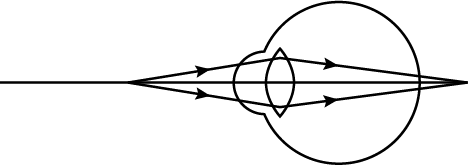
Rewrite the following table so as to match the second and third column with the first column :
| Column I | Column II | Column III | |
| 1 | Myopia | Old age problem | Bifocal lens |
| 2 | Presbyopia | Near-sightedness | Concave lens |
Given diagram is showing a defect of a human eye. Study it and answer the following question:Give the reason for this defects of the eye in the human being.
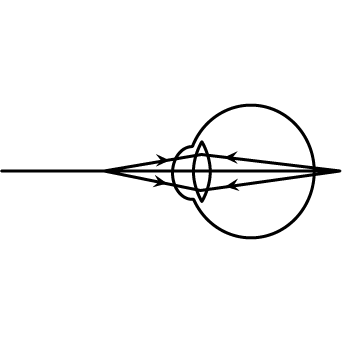
What is myopia? Explain two possible reasons of myopia. How can it be corrected? Explain with suitable diagram.
Rewrite the following table so as to match the second and third columns with the first column :
| Column I | Column II | Column III |
| (1) Dispersion | Long - Sightedness | Twinkling of Stars |
| (2) Refraction | Splitting of white light into component colors. | Convex lens |
| (3) Hypermetropia | Change in the direction of ray of light due to change in medium. | Spectrum of seven colours |
Given below is a diagram showing a defect of the human eye. Study it and answer the following question:Name the type of lens used to correct the eye defect.
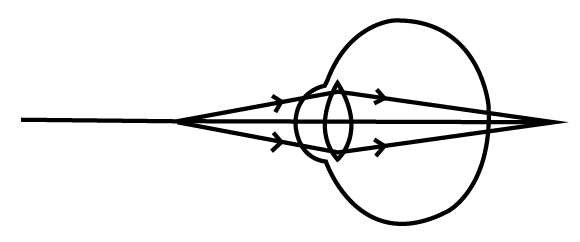
What is dispersion of white light? What is the cause of such dispersion? Draw a diagram to show the dispersion of white light by a glass prism.
My grandfather uses a bifocal lens in his spectacle. Explain why?
Name the two major defects of an eye. Explain causes of their development and discuss methods of their correction.
The sky appears dark instead of blue to an astronaut.Why?
What is meant by short-sightedness?
Choose the correct answer from the alternatives given in the brackets.
The defect myopia can be corrected by using a ..............
(Convex lens, Concave lens, Concave mirror, Convex mirror)
What type of lens is used to correct long-sightedness?
Why is hypermetropia caused? How can it be corrected?
Explain the formation of a mirage.
From the following description write down the names of the parts in human eye.
(a) Dark muscular diaphragm that controls the pupil.
(b) The screen where the image is formed by eye lens.
Explain briefly the reason for the blue colour of the sky.
What is Hypermetropia? How can it be corrected?
Observe the diagram and fill up the following:
a. The diagram shows .......... defect of the eye.
b. .......... lens is used to correct this defect.
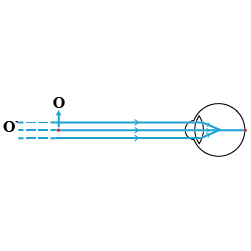
What is myopia? How can it be corrected?
When sunlight passes through the window of the classroom, the path of the light is visible. What is this effect called? Give reason.
What is the cause of Presbyopia?
Least distance of distinct vision of a person is observed as 35 cm. What lens is useful for him to see his surroundings clearly ? Why ?
The optical prescription of a pair of spectacle is - Right eye : - 3.5 D, Left eye : - 4.00 D
i) Name the defect of the eye
ii) Are these lenses thinner at the middle or at the edges?
iii) Which lens has a greater focal length?
a. Draw the given diagram and label the following in the diagram.
i) Incident ray
ii) Refracted ray
iii) Emergent ray
iv) Angle of refraction
v) Angle of deviation
vi) Angle of emergence
b. The refractive index of diamond is 2.What is the meaning of this statement in relation to the speed of light?
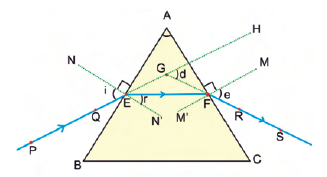
If the far point of a myopic person is $$75 \ cm$$, what should be the focal length of the lens used to rectify this defect?
Why does the sun appear red during sunset and sunrise?
A person cannot clearly see objects farther than $$12 \ m$$ from his eye. Name the defect in vision he is suffering from and the lens that should be used to correct this defect.
Explain with the help of a labelled ray diagram, the defect of hypermetropia and how it is corrected.
Why red colour is given to signals to be viewed from a distance?
Light from the Sun travels in straight lines. Yet, the light reaches our rooms and brightens it. Name the phenomenon of light that causes this.
Draw the diagram of dispersion of light through prism and show the position of different colours of light obtained on screen.
What do you mean by scattering of light?
Blue colour of sky is due to __________.
Define scattering of light.
(a) A person cannot see nearby objects, then write name of eye defect. Write name of lens used to correct this eye defect.
(b) In brief define 'Tyndall effect'.
What is long-sightedness? The near point of a long-sighted person is at $$100 \ cm$$ from his eyes. What would be the power of the lens to be used by him in order to read a book placed at $$25 \ cm$$ from his eyes?
What is myopia (or short sightedness)? What is the cause of this defect? How can this defect be minimized? Explain drawing a ray diagram.
Give scientific reason.
The sun appears reddish early in the morning.
A student is unable to see clearly the words written on the black board placed at a distance of approximately $$3$$ m from him. Name the defect of vision the boy is suffering from. State the possible causes of this defect and explain the method of correcting it.
Why does the sun appear reddish early in the morning? Will this phenomenon be observed by an astronaut on the Moon? Give reason to justify your answer.
Why do stars twinkle? Explain.
Define scattering.
Answer the question in the limit of maximum $$50$$ words.
Describe the dispersion of light by glass prism with neat figure.
State the defect of vision Kavita is suffering from.
Name the type of lens which is used to correct?
i) Myopia ii) Hypermetropia.
Why sun appears red during sunrise & sunset ?
Why does the sky appear white sometimes?
A person with a myopic eye cannot see objects beyond $$1.2\ m$$ distinctly. What should be the type of the corrective lens used to restore proper vision.
With the help of a diagram explain the formation of rainbow in the sky. List two essential conditions for observing a rainbow
A doctor has prescribed a corrective lens of power $$+1.5 \ D$$ to a patient. Find the focal length of the lens in centimeter. Is the prescribed lens diverging or converging?
What is scattering of light?
A ray of white light falls on a prism. Draw ray diagram to show that the prism disperses the white light.
Explain with reason :-
a) Twinkling of stars.
b) Advanced sunset and delayed sunrise.
c) Blue colour of sky.
d) Reddish colour of sky during sunrise and sunset.
With the help of neat and labeled ray diagram explain angle of prism.
Rainbow is an example of dispersion of sunlight.Expalin its formation.
What is a Tyndall effect? Write any two application of tyndal effect.
What is the other name for (a) myopia (b) hypermetropia?
What are the difference between dispersion and scattering
What is the scientific name for:(a) near-sightedness(b) far-sightedness
Name of the defect vision which makes the eye-lens its power of accommodation due to old age.
Name the defects of vision in a person:
$$(a)$$ Whose near point is more than 25 cm away.
$$(b)$$ Whose far point is less than infinity.
What do you mean by scattering of light? Write its use in daily life?
What is old age far-sightedness?
Which defect of vision can be rectified by
a) by using a concave lens
b) by using a convex lens
Watching the sunset on a beach, one can see the sun for several minutes after it has 'actually set'. Explain.
A boy uses spectacles of focal length $$-50cm$$ .Name the defect of vision he is suffering from.
Name the triangle piece of glass that splits white light into 7 colours.
Explain why the planets do not twinkle?
The red colour of sun during sunrise and sunset is due to _____________ of light.
A beam consisting of red, blue and yellow colors is incident normally on the face AB of an isosceles right angled prism ABC as shown in Fig. Complete the diagram to show the refracted and emergent rays.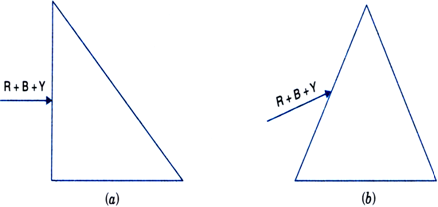

If in a room we turn the light off then the room suddenly becomes very dark but after some while, it is not very much dark. What is the logic behind this?
Name the defect shown in the diagram.
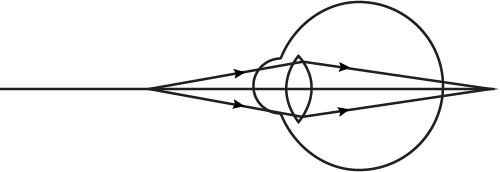
Define angle of deviation.
Fill in the blank :
The impression of an image lasts on the retina for ............. of a second
Draw a labelled diagram to show (i) white appearance of the sun at noon when it is overhead.
Give scientific reasons:
Stars twinkle but we do not see the twinkling of planets.
Write the structure of eye lens and state the role of ciliary muscle in the human eye.
Draw a labelled diagram to show (i) reddish appearance of the sun at the sunrise or the sunset
What is a rainbow? Draw a labelled diagram to show the formation of a rainbow.
What do the ciliary muscles do when you are focusing on a nearby object?
Name two parts of the eye which refract light rays (or bend light rays)
What is the principal function of the eye-lens?
Give the scientific names of the following parts of the eye:
(a) Carries signals from an eye to the brain.
(b) Muscles that change the shape of the eye-lens.
(c) A hole in the middle of the iris.
(d) A clear window at the front of the eye.
(e) Changes shape to focus a picture on the retina.
What changes take place in the shape of eye-lens:
(a) when the eye is focused on a near object?
(b) when the eye is focused on a distant object?
Which part of the eye contains cells which are sensitive to light?
What is the function of the lens in the human eye?
A person wears glasses of power $$-2.5$$D. Is the person farsighted or nearsighted? What is the far point of the person without the glasses?
What change is made in the eye to enable it to focus on objects situated at different distances? Illustrate your answer with the help of diagrams.
Name the part of our eyes which helps us to focus near and distant objects in quick succession.
What is the far point of a person suffering from myopia (or short-sightedness)?
Describe and explain, how a normal eye can see objects lying at various distances clearly.
Name the defect of vision which can be corrected by a diverging lens. Show clearly by a ray diagram how the lens corrects the defect.
Name the body part with which the terms myopia and hypermetropia are connected.
Ciliary muscles of human eye can contract or relax. How does it help in the normal functioning of the eye?
What is the other name of old age hypermetropia?
Your friend can read a book perfectly well but cannot read the writing on the blackboard unless she sits on the front row in class.
(a) Is she short-sighted or long-sighted?
(b) What type of lenses-converging or diverging-would an optician prescribe for her?
Where is the near point of a person suffering from hypermetropia (or long-sightedness)?
The near-point of a person suffering from hypermetropia is at 50 cm from his eye. What is the nature and power of the lens needed to correct this defect? (Assume that the near-point of the normal eye is 25 cm).
Name the defect of vision in a person:
(a) whose near point is more than 25 cm away.
(b) whose far point is less than infinity.
What is presbyopia? Write two causes of this defect. Name the type of lens which can be used to correct presbyopia.
A person can read a book clearly only if he holds it at an arm's length from him. Name the defect of vision:
(a) if the person is an old man
(b) if the person is a young man
State whether the following statement is true or false:
Rabbit has eyes that look sideways.
What is the order of colours in a rainbow, from the outside to the inside?
A person needs a lens of power, $$- 5.5 \ dioptres$$ for correcting his distant vision. For correcting his near vision, he needs a lens of power, $$+1.5 \ dioptres$$. What is the focal length of the lens required for correcting
1. Distant vision, and
2. Near vision?
In a certain murder investigation, it was important to discover whether the victim was long-sighted or short-sighted. How could a detective decide by examining his spectacles?
How much is our field of view:
(a) with one eye open?
(b) with both eyes open?
Out of animals of prey and predators, which have their eyes:
At the front of their head?
On the opposite sides of their head?
Fill in the following blanks with suitable words:
A person is short-sighted if his eyeball is too ......... Spectacles with a .......... lens are needed.
A person is long-sighted if his eyeball is too ......... Spectacles with a .......... lens are needed. These focus light rays exactly on to the .......
A short-sighted person has a near point of 15 cm and a far point of 40 cm.
(a) Can he see clearly an object at a distance of:
(i) 5 cm ? (ii) 25 cm ? (iii) 50 cm ?
(b) To see clearly an object at infinity, what kind of spectacle lenses does he need?
Explain why, the sun can be seen about two minutes before actual sunrise. Draw a diagram to illustrate your answer.
State whether the following statement is true or false:
The planets twinkle at night due to atmospheric refraction of light.
Draw a diagram to show how white light can be dispersed into a spectrum by using a glass prism. Mark the various colours of the spectrum.
Why do you not see a spectrum of colours when light passes through a flat pane of glass?
Name the phenomenon which causes the twinkling of stars.
Why do stars seem higher than they actually are? Illustrate your answer with the help of a diagram.
What is tyndall effect? Explain with an example
State two effects produced by the scattering of light by the atmosphere.
Fill in the following blanks with suitable words:
We can see the sun about ........ minutes before the actual sunrise and about ........ minutes after the actual sunset because of atmospheric .......
By how much time the day would have been shorter if the earth had no atmosphere?
In an experiment to study the scattering of light by passing a beam of white light through a colloidal solution of sulphur in a transparent glass tank:
(a) Which colour is observed from the front of the glass tank? Does this colour correspond to the colour of sky on a clear day or the colour of sky around the sun at sunset?
(b) Which colour is observed from the sides of the glass tank? Does this colour correspond to the colour of sky on a clear day or the colour of sky around the sun at sunset?
Why does the sky appear blue on a clear day?
Why does the sun appear red at sunrise?
The ciliary muscles of a normal eye are in their (i) most relaxed (ii) most contracted state. In which of the two cases is the focal length of the eye-lens more?
What is meant by 'persistence of vision'? We are able to see movie picture in a cinema hall. How does this happen?
Draw a ray diagram showing the dispersion through a prism when
a narrow beamof white light is incident on one of its refracting surfaces. Also,
indicate the order of thecolours of the spectrum obtained.
Can an observer see a rainbow on the moon?
News spread in the school that a student of Class IX-A has expired due to heart attack, but he has donated his beautiful eyes to one of his friends. All the members of school felt very sad for his untimely death, but on the other hand they were overwhelmed on hearing the donation of his eyes to his friend, who would now be able to see this beautiful nature.
Answer the following questions based on the situation given above.
(i) Do you think that the student who expired had done good job? Is it worth to donate vital organs?
(ii) What values are promoted here?
(iii) What other organs can be donated after death?
Is the position of a star as seen by us its true position? Justify
your answer.
Why do we see a rainbow in the sky only after rainfall?
How are we able to see nearby and also the distant objects clearly?
A person needs a lens of power -4.5 D for correction of her vision.
(a) What kind of defect in vision is she suffering from?
(b) What is the focal length of the corrective lens?
(c) What is the nature of the corrective lens?
Explain the structure and functioning of the human eye. How are we able to see nearby as well as distant objects?
A beam of white light falling on a glass prism gets split up into seven colours marked $$1$$ to $$7$$ as shown in the diagram.
A student makes the following statements about the spectrum observed on the screen.
(a) The colours at positions marked $$3$$ and $$5$$ are similar to the colour of the sky and the colour of gold metal respectively.
Is the above statement made by the student correct or incorrect? Justify.
(b) Which two positions correspond closely to the colour of (i) brinjal, (i) 'danger' or stop signal lights?
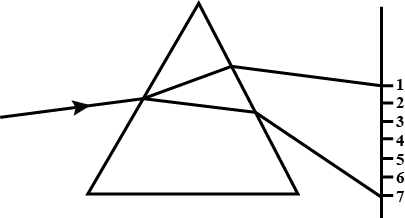
Mention any four phenomena that can be observed due to atmospheric refraction of light on the earth.
How can we explain the reddish appearance of sun at sunrise or sunset? Why does it not appear red at noon?
A myopic adult has a far point at $$0.1m$$. His power of accommodation is $$4$$ diopters
(i) What power lenses are required to see distant objects
(ii) What is his near point without glasses?
(iii) What is his near point with glasses? (Take the image distance from the lens of the eye to the retina to be $$2cm$$)
Explain the phenomenon of
dispersion of white light through a glass prism, using suitable ray diagram.
The color of sky in direction other than of the sun is blue. Explain:
When do we consider a person to be myopic or hypermetropic? Explain
using diagrams how the defects associated with myopic and hypermetropic eye can
be corrected?
How does the deviation produced by a triangular prism depend on the colours (or wavelength) of light incident on it ?
The clouds are seen white. Explain.
Will the focal length of a lens for red light be more, same or less than that for blue light?
The diagrams (a) and (b) in figure above show the refractions of a monochromatic ray of light through a parallel sided glass block and a prism, respectively. In each diagram, label the incident, refracted, emergent rays and the angle of deviation.
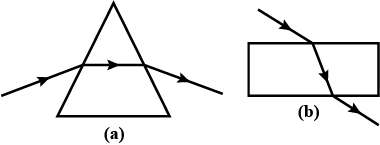
A convex lens of suitable focal length can rectify which defect of vision?
What holds the crystalline lens in the human eye?
Name the light-sensitive part of the eye where image of an object is formed.
Match the columns in the following table and explain them.
| Column $$1$$ | Column $$2$$ | Column $$3$$ |
| Farsightedness | Nearby object can be seen clearly | Bifocal lens |
| Presbyopia | Far away object can be seen clearly | Concave lens |
| Nearsightedness | Problem of old age | Concave lens |
Distinguish between presbyopia and hypermetropia.
What is the direction of rainbow formation? What is the position of red colour in the rainbow?
In which type of eye defect , the near point of the eye becomes more than $$ 25 cm? $$
Give reason for the early sunrise and the delayed sunset
Give the difference between myopia and hypermetropia
The far point of a myopic person is 83 cm in front of the eye. What is the nature and power of the lens required to correct the problem?
What is the scattering of light ? On what factors does it depend ?
What causes presbyopia? Name the lens to correct this defect.
What is the reason for Advance sunrise and delayed sunset?
Which colour deviates the least?
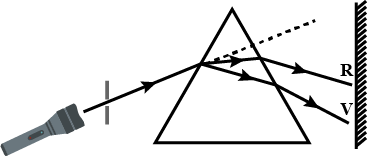
In the experiment using hypo solution to demonstrate scattering of light, when hydrochloric acid was added to the solution, which colour did spread first in the solution?
Write down what else can be done to minimize the light pollution.
Make Newtons disc by painting the constituent colours of white col-our of white light in the same order and proportion.
The disc appeared white due to the persistence of vision. Find out more examples of the persistence of vision and write them down.
Where will be the sun when the rainbow is seen in the west?
Which component colour in white light does undergo maximum scattering in the atmosphere?
The western horizon remains reddish for some more time even after sunset. Why?
Fill in the blanks :
After the rain when the sun is low in the sky the ................ appears in the Sky.
How many colours are there in Rainbow?
The image formation of a defected eye is given below
a. In which position images formed on a normal eye?
b. What is this eye defect?
c. How to solve this defect? Draw the diagram.

Why does the path of light seen when dust particles are spread in cinema theatre and smart room.
Find the appropriate terms from the box for the statements given below.
Red, Scattering, Refraction, Dispersion Phenomenon responsible for the Tyndal effect.
Under what conditions is a mirage formed? While driving on a hot day, sometimes you see what appears to be water on the road far ahead. When you arrive at the location of the water, however, the road is perfectly dry. Explain this phenomenon.
Analyse the following statements and find out the reason behind them.
Raindrops falling down during rain appear like a glass rod.
Analyse the following statement and find out the reason behind it.
A rainbow is seen in the shape of a full circle when viewed from a height.
A person sees clearly wearing eyeglasses that have a power of -4.00 diopters when the lenses are 2.00 cm in front of the eyes. (a) What is the focal length of the lens? (b) Is the person nearsighted or farsighted?(c) If the person wants to switch to contact lenses placed directly on the eyes, what lens power should be prescribed?
What is a mirage? How is it formed?
A child sitting at the backbench of a classroom is unable to see the letters on the board clearly. What is the defect of the eye of the child? How can it be remedied? Draw its ray diagram.
Find the appropriate terms from the box for the statements given below.
Red, Scattering, Refraction, Dispersion
Phenomenon responsible for Rainbow.
A person is advised to wear spectacles with convex lenses. What type of defect of vision is he suffering from ?
The far point of a myopic person is $$80$$ cm in front of the eye. What is the nature and power of the lens required to correct the problem?
A certain child’s near point is $$10.0 \ cm$$; her far point(with eyes relaxed) is $$125 \ cm$$. Each eye lens is $$2.00 \ cm$$ from the retina. (a) Between what limits, measured in diopters, does the power of this lens–cornea combination vary? (b) Calculate the power of the eyeglass lens the child should use for relaxed distance vision. Is the lens converging or diverging?
(i) Show the formation of the rainbow with the help of a ray diagram.
(ii) What are the conditions to observe the rainbow?
Given an example of optical phenomenon where Tyndall effect can be observed.
A person is advised to wear spectacles with concave lenses. What type of defect of vision is he suffering from ?
Name the atmospheric phenomenon due to which the sun can be seen above the horizon about two minutes before actual sunrise.
The accommodation limits for a near-sighted person’s eyes are $$18.0 \ cm$$ and $$80.0 \ cm$$. When he wears his glasses, he can see faraway objects clearly. At what minimum distance is he able to see objects clearly?
A convex lens made of glass forms a sharp image on the screen for a particular position of an object with respect to the lens. A human eye lens is also a convex lens but it can form sharp images on the retina of eye for different positions of the objects. Explain, why?
A $$52$$-year old near-sighted person wears eye-glass with a power of $$5.5$$ dioptres for distance viewing. His doctor prescribes a correction of $$+1.5$$ dioptres in the near-vision section of his bi-focal. This is measured relative to the main part of the lens (i) What is the focal length of his distance-viewing part of the lens? (ii) What is the focal length of the near-vision section of the lens?
What is the defect of vision in the human eye? Vishal unable to see the far object clearly. So which type of defect of vision does it posses, explain it.
A $$14$$-year old student is not able to see clearly the questions written on the blackboard placed at a distance of $$5\ m$$ from him.
(a) Name the defect of vision he is suffering from.
(b) With the help of labelled ray diagrams show how this defect can be corrected.
(c) Name the type of lens used to correct this defect.
A star sometimes appears brighter and some other times fainter. What is this effect called? State the reason for this effect.
(a) What is meant by the power of accommodation of an eye?
(b) A person with a myopic eye cannot see objects beyond $$1.2\ m$$ directly. What should be the type of the corrective lens used? What would be its power?
A person with a myopic eye cannot see objects beyond $$1.2\ m$$ directly. What should be the type of corrective lens used? What would be its power?
(a) A student cannot see clearly a chart hanging on a wall placed at a distance $$3\ m$$ from his eye. Name the defect of vision he is suffering from. Draw a ray diagram to illustrate this defect. List its two possible causes.
(b) Draw a ray diagram to show how this defect may be corrected using a lens of appropriate focal length.
What is hypermetropia (far-sighted-ness)? Draw a ray diagram to show how this defect can be corrected using a lens.
Explain why do the planets not twinkle but the stars twinkle.
In the figure given below, a narrow beam of white light is shown to pass through a triangular glass prism. After passing through the prism, it produces a spectrum $$XY$$ on the screen.
(i) Name the phenomenon.
(ii) State the colours seen at $$X$$ and $$Y$$.
(iii) Why do different colours of white light bend at different angles through a prism?
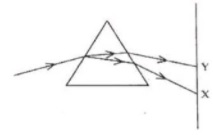
Mirage is an example of _____
Solve the following crossword with the help of the given clues:
Across
(1) A microscope consisting two convex lenses
(3) The jelly-like substances that fills the area of the eyeball between the retina and the lens.
(5) A lens mounted in a frame used to make an object appear layer than it really is
(7) The organ of the body with which humans are able to see
(9) The clear, watery fluid that fills the chamber of the eye between the cornea and the lens.
(11) An optical instrument used to view distant objects. It makes far away objects appear larger when viewed through it.
(12) Defect of human eye, by virtue of which a person can see clearly the distant objects but we the nearby objects.
Down
(1) The front transparent part of the eye that is bulged outwards. Light from objects enter the eye through it.
(2) An optical device consisting of a conve lens of small focal length that is used to make things.
(4) An apparatus for taking photographs.
(6) The flat-coloured membrane in the lens that contacts the size of the pupil
(8) The opening in the centre of the iris through wheels light enters the eye.
(10) The defect of human eye due to which a person is able to near objects at close range better than distant objects.
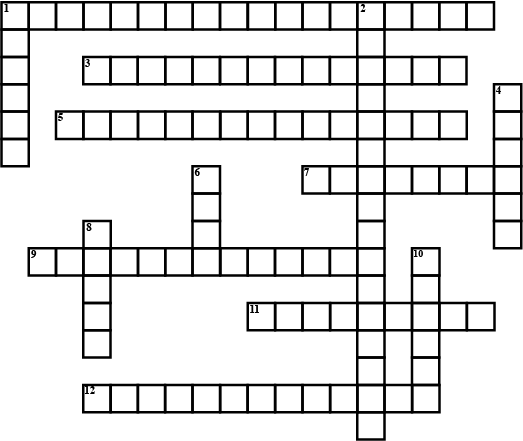
In a Std. X class, out of $$40$$ students, $$10$$ students use spectacles, $$2$$ students have positive power and $$8$$ students have negative power of lenses in their spectacles.
Answer the following questions :
(i) What does the negative power indicate?
(ii) What does the positive power indicate?
(iii) Generally which type of spectacles do most of the students use?
(iv) What defect of eyesight do most of the students suffer from?
(v) Give two possible reasons for the above defect.
Mirage formation is due to _____
A student finds the writing on the blackboard as blurred and unclear when sitting on the last desk in the classroom. He however, sees it clearly when sitting on the front dest at an approximate distance of 2 m from the blackboard. Draw ray diagrams to illustrate the formation of image of the blackboard writting by his eye - lens when he is seated at the (i) last desk (ii) front desk
Name the kind of lens that would help him to see clearly even when he is seated at the last desk. Draw a ray diagram to illustrate how this lens helps him to see clearly.
(a) A student suffering from myopia is not able to see distinctly the objects placed beyond $$5 m$$. List two possible reasons due to which this defect of vision may have arisen. With the help of ray diagrams, explain
(i) why the student is unable to see distinctly the objects placed beyond $$5m$$ from his eyes.
(ii) the type of the corrective lens used to restore proper vision and how this defect is corrected by the use of this lens.
(b) If, in this case, the numerical value of the focal length of the corrective lens is $$5m$$, find the power of the lens as per the new Cartesian sign convention.
Explain with the help of a labelled ray diagram the defect of myopia and how it is corrected.
State the defects of vision in human eyes and its remedies. Explain the defect of myopia and remedies to control it.
a) Complete Fig. A and Fig. B indicating the changes the incident rays undergo as they pass through and come out of the prisms.
b) On completion if there is any difference between A and B. Mention the reason for it.
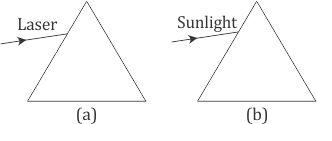
You know that myopia is a common refractive defect of vision. Person with this defect can see only nearby objects. Using concave lens of suitable power this defect is corrected.
(a) Mention other two types of defects like this.
(b) Explain how we can correct it.
The given diagram is showing a defect of the human eye. Study it and answer the following question: Name the defect shown in the figure.
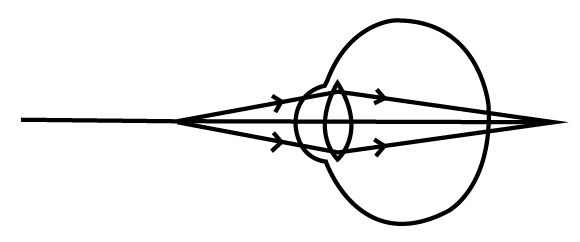
What is myopia? How does it occur? How can it be corrected? Explain with figure.
What is hypermetropia? What are the possible reasons of hypermetropia? How is hypermetropia corrected? Explain with figures.
What are myopia and hypometropia? How are they corrected, explain using a diagram.
A person with a hypermetropia eye cannot see objects beyond $$1$$ metre directly. What should be the type of the corrective lens used? What would be its power?
Complete the following sentence :(I). A short-sighted person cannot see ............... object clearly. Short-sightedness can be correct by using ........... lenses.(II). A long-sighted person cannot see .............. object clearly. Long-sightedness can be corrected by using ............ lenses.
The range of vision of a person is $$50\ cm - 120\ cm$$ which defect of vision is he suffering from?
A student sitting in the last row of the class-room is not able to read clearly the writing on the blackboard. (I) Name the type of defect he suffering from.(II) How can these defect by corrected?
A man is suffering from myopia, cannot see objects beyond $$10.0\ m$$ distinctly. What should be the type of corrective lens used to restore proper vision? Find the focal length and power of the lens?
Your friend can read a book perfectly well but cannot read the writing on the blackboard unless she sits on the front row in class. Is she short-sighted or long-sighted?
The near point of a hyper metropic person is $$50$$cm from the eye. What is the power of the lens required to enable the person to read clearly a book held at $$25$$cm from the eye?
Define Tyndall effect?
You are given that the diameter of the eyeball is about $$2.3$$ cm and a normal eye can adjust the focal length of its eye lens to see objects situated anywhere from $$25$$ cm to an infinite distance away from it.What is the power of the (normal) eye lens, when ciliary muscles are fully relaxed?
What is the power of the (normal)eye lens, when ciliary muscles are in their maximum contract position?
The maximum variation in the power of the eye lens, when it adjusts itself, from the normal relaxed position to the position where the eye can see the nearby object clearly?
Name two phenomenon responsible for rainbow formation
(i) What is myopia? state the two cause of myopia. With the help of labelled ray diagrams show
(a) the eye defect myopia
(b) correction of myopia using a lens.
(ii) Why is the normal eye unable to focus on an object placed within $$10\,cm$$ from the eye?
Explain the blue appearance of sky ?
How the eye of a person suffering from myopia can be corrected? Explain with the help of a ray diagram.
(a) What is short-sightedness? State the two causes of short-sightedness (or myopia). With the help of ray diagrams, show:
the eye-defect short-sightedness.
correction of short-sightedness by using a lens.
(b) A person having short-sightedness cannot see objects clearly beyond a distance of 1.5 m. What would be the nature and power of the corrective lens used to restore proper vision?
(a) What is atmospheric refraction? What causes atmospheric refraction?
(b) Why do stars twinkle on a clear night?
(c) Explain why, the planets do not twinkle at night.
Name the defect of vision which can be corrected by a converging lens. Show dearly by a ray diagram how the lens corrects the defect.
A person suffering from the eye-defect myopia (short-sightedness) can see clearly only up to a distance of 2 metres. What is the nature and power of lens required to rectify this defect?
(a) Draw a diagram to show the refraction of light through a glass prism. On this diagram, mark
incident ray
emergent ray, and
angle of deviation.
(b) What is a rainbow? What are the two conditions necessary for the formation of a rainbow in the sky?
(c) What acts as tiny prisms in the formation of a rainbow?
(d) Name the process which is involved in the formation of a rainbow.
(e) What are the seven colours seen in a rainbow?
Explain with the help of labelled ray-diagram, the defect of vision called hypermetropia, and how it is corrected by a lens.
We know that light refracts (or bends) when it goes from one medium to another. Now, the atmosphere contains only air. Then how does light get refracted on passing through only air in the atmosphere?
(a) Draw a neat and labelled diagram of the experimental set up for observing the scattering of light in a colloidal solution of sulpher to show how the sky appears blue, and the sun appears red at sunrise and sunset.
(b) Out of blue light and red light, which one is scattered more easily?
(c) Which component of sunlight is scattered away when the sun appears red at sunrise or sunset?
(d) What causes the scattering of blue component of sunlight in the atmosphere?
Which effect is illustrated by the observation that when a beam of sunlight enters a dusty room, then its path becomes visible to us.
What is the cause for Hypermetropia ? Show the defective eye and explain how it is converted ?
A student claims that because of atmospheric refraction, the sun can be seen after it has set and before the rise, therefore, therefor days become longer than if the earth had no atmosphere.
(a) What does the student mean by saying that the sun can be seen after it has set?
(b) Do you think that the students' conclusion is correct?
When sunlight enters the earth's atmosphere , state which colour of light is scattered the most and which the least .
Sania and Shreya are best friends and study in gradeRecently, Sania has been facing difficulty in reading the blackboard text from the last desk. Shreya is little uncomfortable and wonders why Sania complains sitting on the last desk. On observation, she found that Sania often carries junk food in her lunch. Shreya has started sharing her lunch – full of green vegetables and fruits with her. Sania is now better and has also started taking a 'balanced diet'.
Answer the following questions based on the above situation:
(i) Name the eye defect Sania is suffering from? What are the two possible reasons related to her eye defect?
(ii) What value is displayed by Shreya and Sania?
(iii) How can this value be promoted? Suggest one activity.
On the rainy day, Ram reached his grandfather's place in village. On the way to house he saw a beautiful rainbow in the sky. In night, he saw lots of twinkling stars in the clear sky. He was very excited to see these beautiful natural phenomena, which he was not able to see in the city, where he lived with his father.
Answer the following questions based on the situation given above.
(i) Do you think that pollution in atmosphere affects the formation of rainbow and twinkling of stars?
(ii) Do you agree with the fact that pollution-free environment will strengthen such natural phenomena in the cities as well?
(iii) What steps can be taken so that the natural phenomena can be enjoyed in cities as well?
How does refraction take place in the atmosphere? Why do stars twinkle but not the planets?
What is a prism?
With the help of a diagram of a prism, indicate its refracting surfaces, refracting edge and base.
Figure(a) shows the basic structure of a human eye. Light refracts into the eye through the cornea and is then further redirected by a lens whose shape (and thus ability to focus the light) is controlled by muscles. We can treat the cornea and eye lens as a single effective thin lens.A “normal” eye can
focus parallel light rays from a distant object O to a point on the retina at the back of the eye, where the processing of the visual information begins. As an object is brought close to the eye, however, the muscles must change the shape of the lens so that rays form an inverted real image on the retina. (a) Suppose that for the parallel rays of Figures, the focal length f of the effective thin lens of the eye is $$2.50$$ cm. For an object at distance $$p = 40.0\,cm$$, what focal length f' of the effective lens is required for the object to be seen clearly? (b) Must the eye muscles increase or decrease the radii of curvature of the eye lens to give focal length f'?
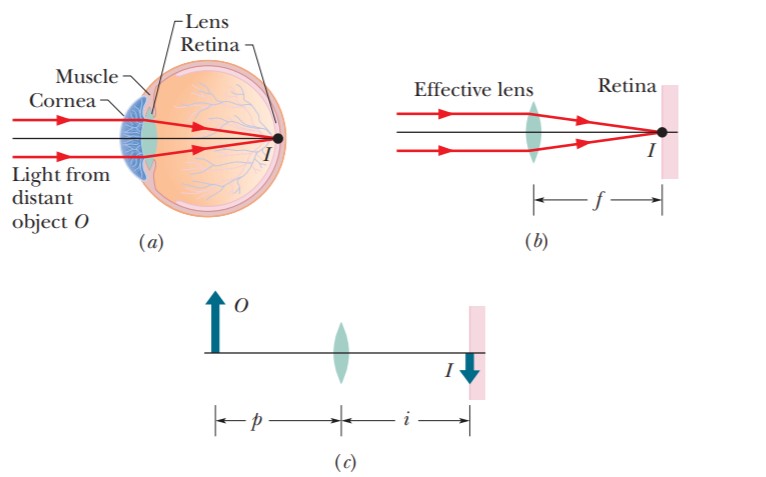
Name three refractive defects of vision with the help of diagram. Explain the reasons and correction of these defects.
Draw a diagram to show the formation of image of a distant object by a myopic eye. How can such an eye defect be remedied?
What is the cause of rainbow ?
Write a note on twinkling of stars.
Explain different types of vision defects and their rectification.
Explain the formation of rainbow with a neat figure.
Give the reason for two minute early sunrise.
Name the factor on which the scattering of light depends.
Which colour deviates the most due to dispersion?
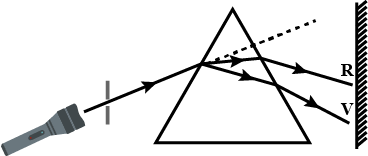
When light passes through the prism, as the wavelength increases, how does the deviation change? Will it increase or decrease?
Where will be the sun when the rainbow is seen in the east?
Draw a neat diagram showing
(a) neat point of an eye
(b) Hypermetropic eye
(c) correction for Hypermetropic eye.
Pass sunlight through a prism and allow it to fall on a screen. What are the colours seen on the screen?
The beam of white light from a torch is allowed to fall obliquely on the glass prism.
Which are the colours formed on the screen placed behind the prism?
What is the defect of vision in the human eye ? State its types and explain in detail.
During sunset, the sun appears red. What may be the reason?
What may be the reason behind this difference in deviation?
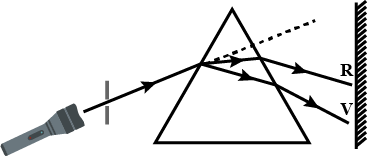
When is the rainbow formed?
A spectrum is obtained by passing white light from a torch through a glass prism. Draw a figure that represents the experiment.
Which are the occasions when the sunlight has to travel a greater distance through the atmosphere before reaching the eyes of an observer on the earth?
A person is not able to see objects beyond $$1.3$$ m. What remedy can you suggest for this defect?
What is the reason for using red light as signal lamps?
Observe the figure
Which are the colours formed on the screen?
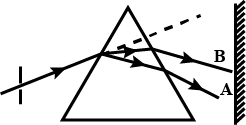
The telescope called Chandra X-ray Observatory is placed in the outer space. What is the advantage of placing it there? Explain with reference to the scattering of light in the atmosphere.
Match the columns A, B and C suitably
| A | B | C |
| Light makes tiny particles visible due to scattering | Dispersion | Pictures on a TV screen keep on changing and give an illusion of motion. |
| The effect of seeing an object is retained by the eye for 1/16 of a second. | Tyndal Effect | Formation of rainbow on the horizon |
| Composite light splits up into component colours | Persistence of vision | On foggy morning the path of sunlight becomes clearly visible. |
